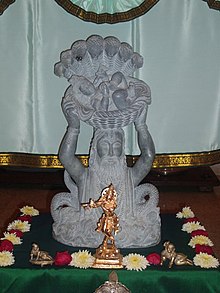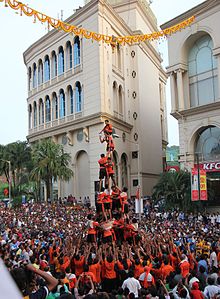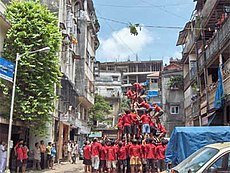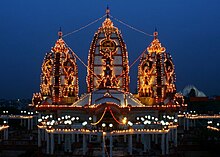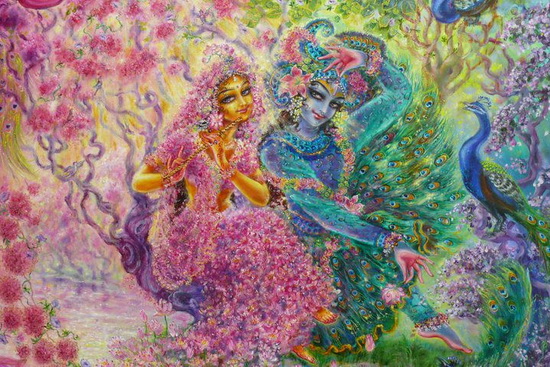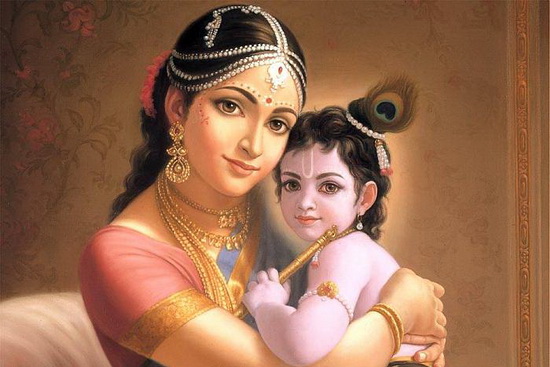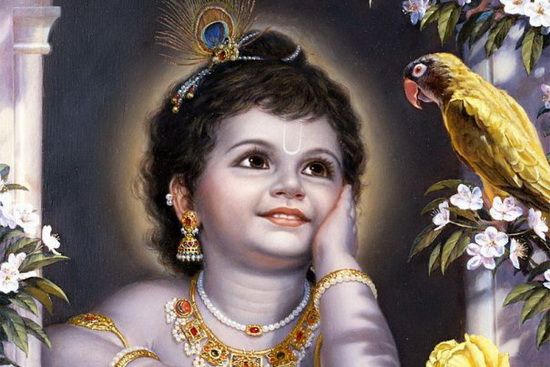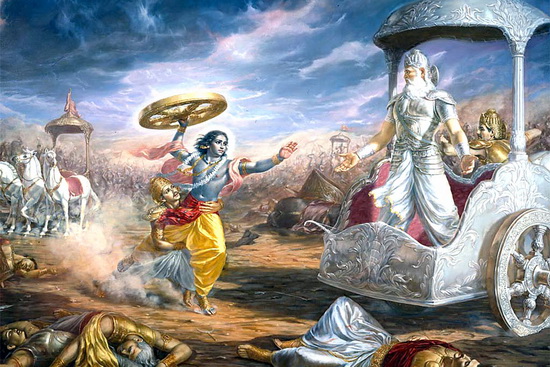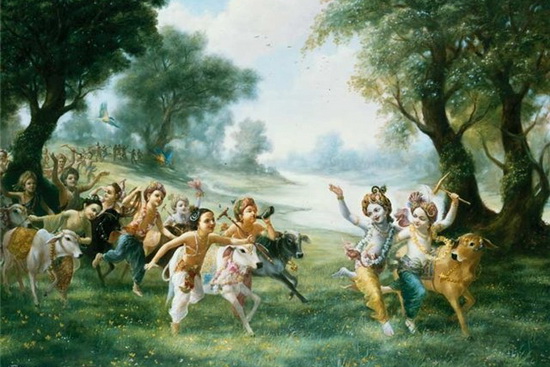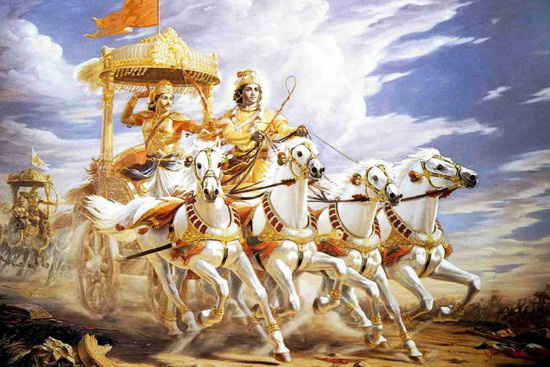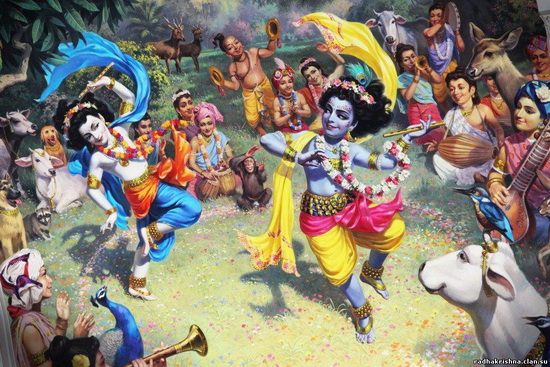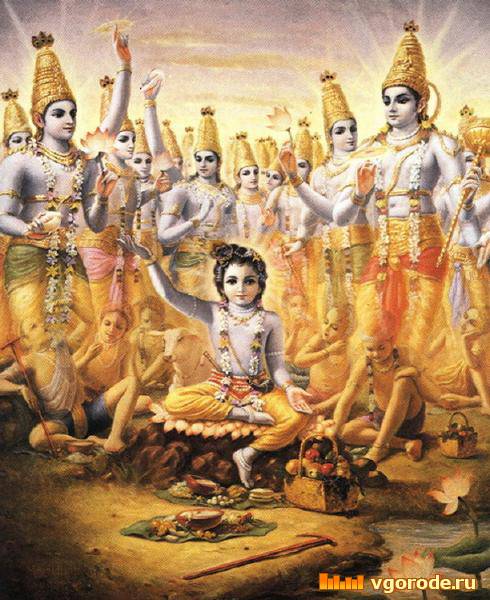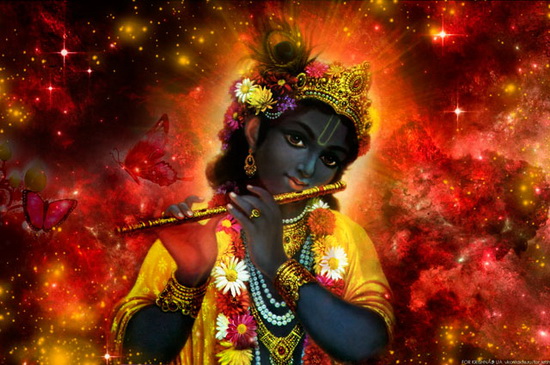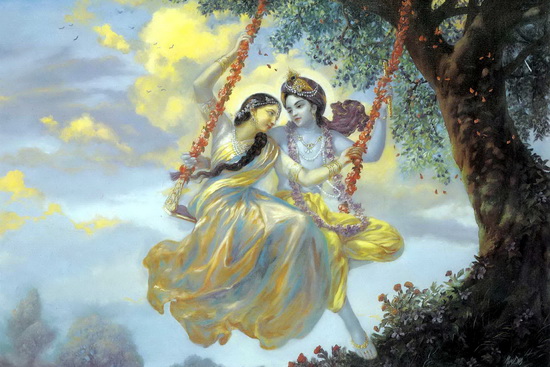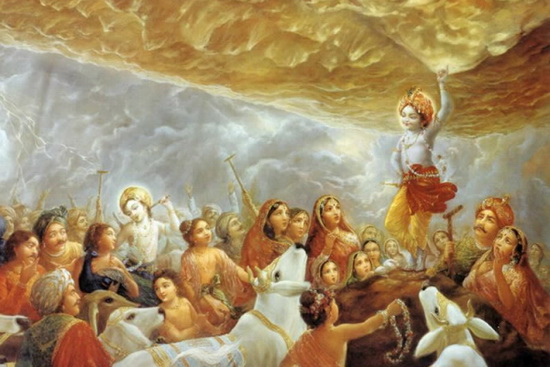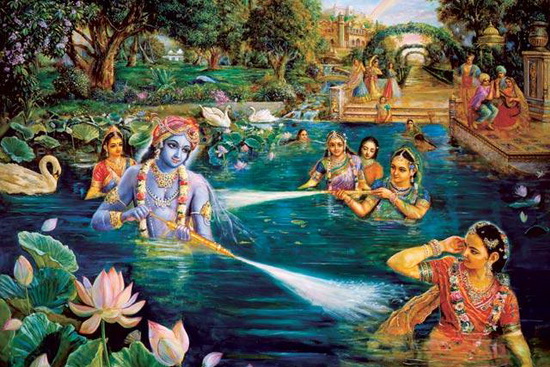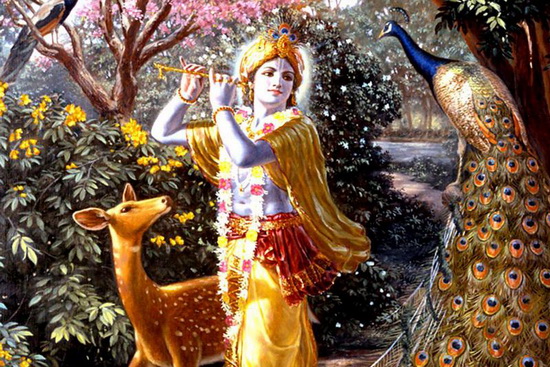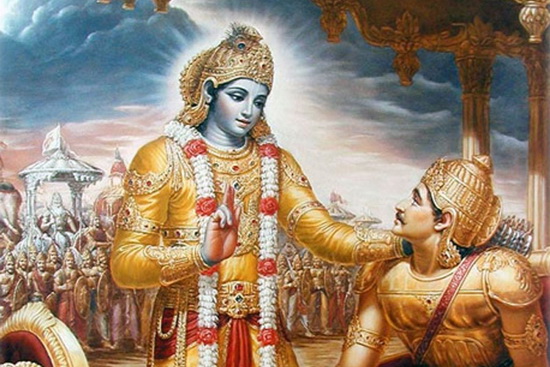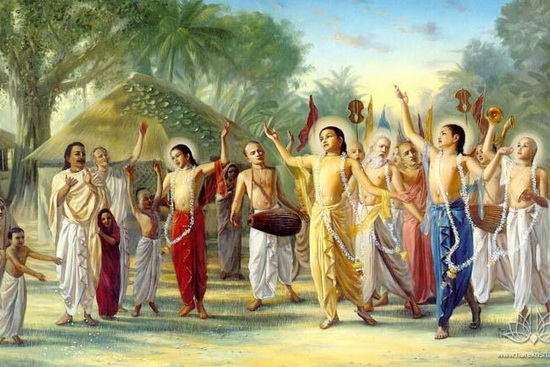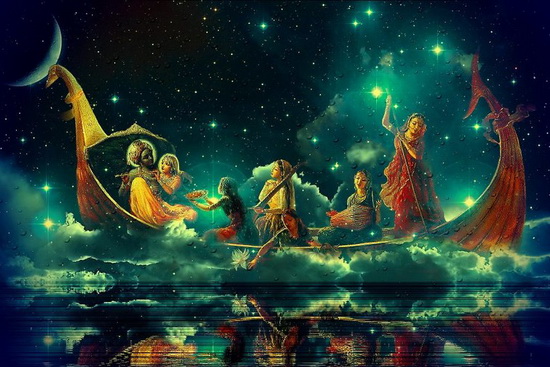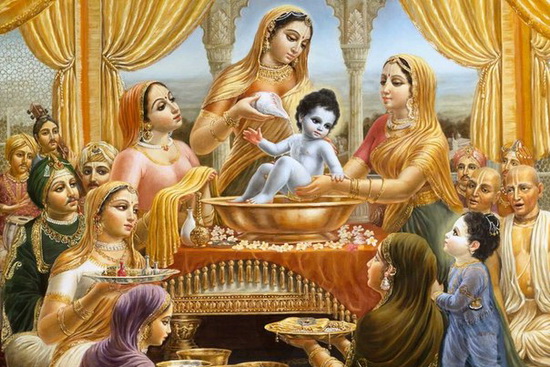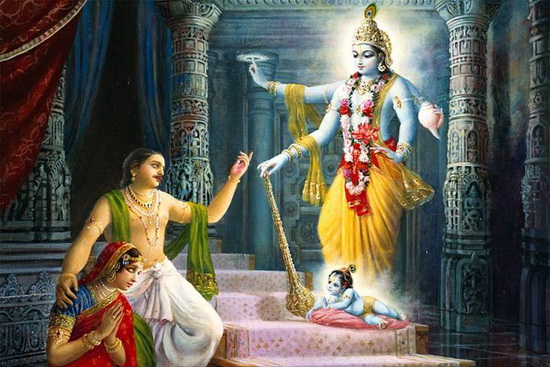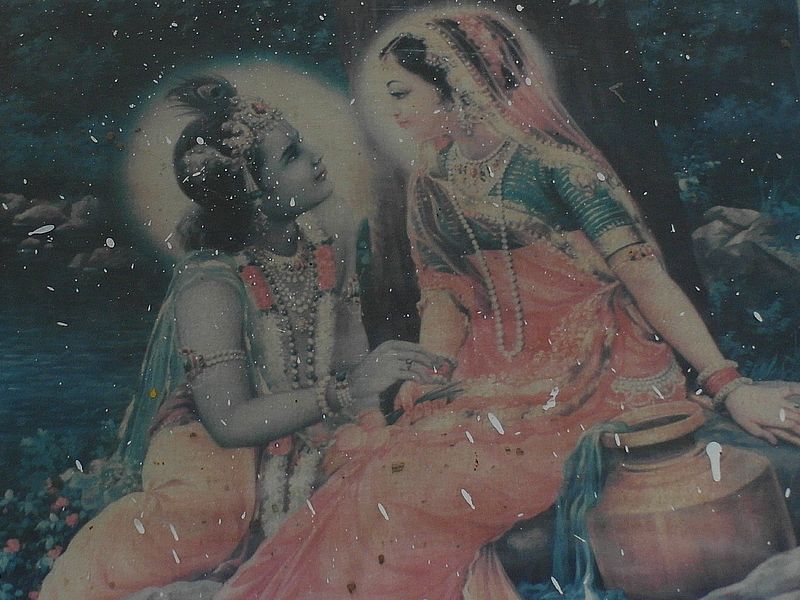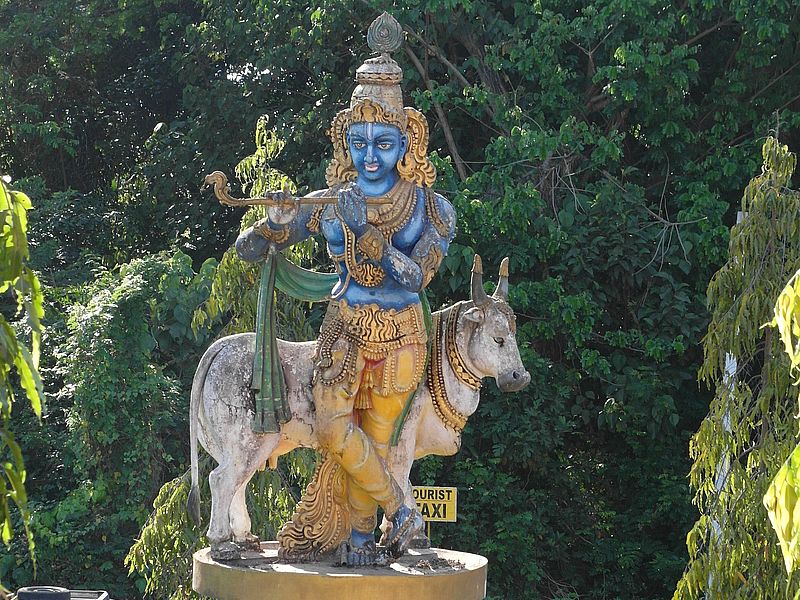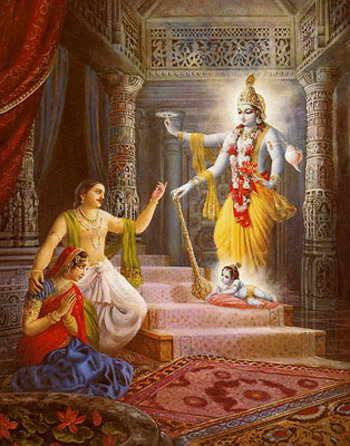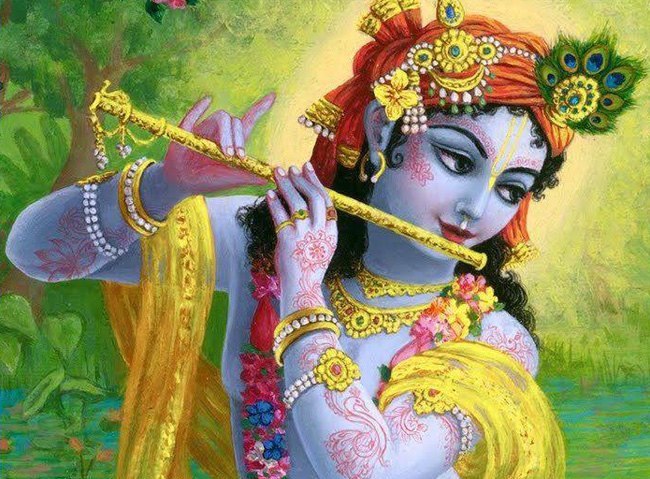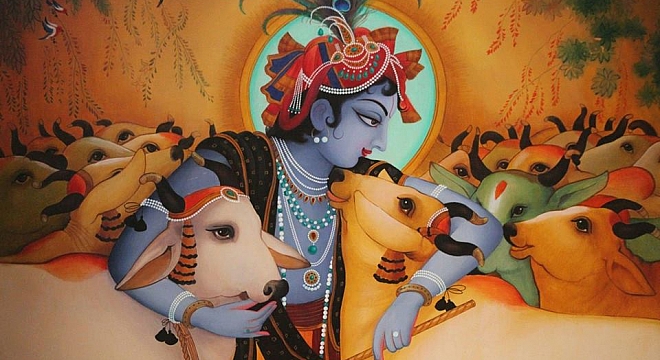Дата события уникальна для каждого года. В 2023 году эта дата — 6 сентября

)
Шри Кришна Джанмаштами (Krishna Janmashtami) — День явления Кришны — это знаменательный ведический праздник, который отмечается очень широко в Индии и является всенародным (несмотря даже на вероисповедание).
Кришна представляет абсолютное значение жизни, которое находится в основе мироздания за пределами всего. Веды считают Шри Кришну Верховной личностью бога, причиной всех причин. Один из переводов на языке санскрита означает «Всепривлекающий».
Вьясадев, мудрец просветленного видения и величайший из историков древности, свидетельствовал рост неправедности в семьях тех, кто правил людьми около пяти тысяч лет тому назад. Именно тогда пришел Кришна, чтобы напомнить человеку об истинных ценностях жизни и образа жизни. Он восстановил тот непосредственный контакт с трансцендентальным Бытием, которое единственно может дать полноту каждому аспекту жизни. Таково учение вечной Истины, данное Кришной Арджуне в Бхагавад Гите.
Постепенно это учение стало забытым, тысячи лет спустя даже принцип Бытия оказался затемненным ложными верованиями, которые прославляли только относительные аспекты жизни. «Большой промежуток времени, — говорит Кришна, — вот причина такой утраты мудрости».
Кришна явился в Аштами (8-й лунный день), когда Чандра (Луна) была убывающей. Когда настало время Его рождения, все планеты заняли самое благоприятное положение. В этот момент повсюду установилась благоприятная атмосфера мира и процветания. В небе видны были благоприятные знаки, а на земле людей воцарилось счастье. Кришна, хотя и является источником материального творения, Он никогда не соприкасается с материей и является в своем изначальном духовном теле, состоящем из вечности, знания и блаженства.
| Krishna Janmashtami | |
|---|---|
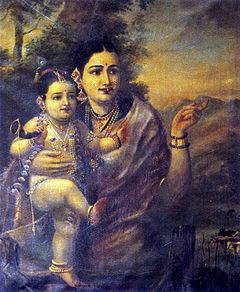
Krishna with his foster mother Yashoda |
|
| Also called |
|
| Observed by | Hindus |
| Type | Religious (1–2 days), cultural |
| Celebrations | Dahi Handi (next day, in the north), kite-flying, drawing footprints of infant Krishna, fasting, traditional sweet dishes, etc. |
| Observances | Dance-drama, puja, night vigil, fasting |
| Date | Shraavana 23 (amanta tradition) Bhadrapada 8 (purnimanta tradition) |
| 2022 date | 18–19 August[1] |
| 2023 date | 6–7 September[2] |
|
Hindu festival dates The Hindu calendar is lunisolar but most festival dates are specified using the lunar portion of the calendar. A lunar day is uniquely identified by three calendar elements: māsa (lunar month), pakṣa (lunar fortnight) and tithi (lunar day). Furthermore, when specifying the masa, one of two traditions are applicable, viz. amānta / pūrṇimānta. Iff a festival falls in the waning phase of the moon, these two traditions identify the same lunar day as falling in two different (but successive) masa. A lunar year is shorter than a solar year by about eleven days. As a result, most Hindu festivals occur on different days in successive years on the Gregorian calendar. |
|
Krishna Janmashtami lit. »Occasion of the birth of Krishna», also known simply as Krishnashtami, Janmashtami, or Gokulashtami, is an annual Hindu festival that celebrates the birth of Krishna, the eighth avatar of Vishnu.[5] According to the Hindu lunisolar calendar, it is observed on the eighth tithi (Ashtami) of the Krishna Paksha (dark fortnight) of Shraavana Masa (according to the amanta tradition) or Bhadrapada Masa (according to the purnimanta tradition). This overlaps with August or September of the Gregorian calendar.[5]
It is an important festival, particularly in the Vaishnavism tradition of Hinduism.[6] Dance-drama enactments of the life of Krishna according to the Bhagavata Purana (such as Rasa Lila or Krishna Lila), devotional singing through the midnight when Krishna was born, fasting (upavasa), a night vigil (Ratri Jagaran), and a festival (Mahotsav) on the following day are a part of the Janmashtami celebrations.[7] It is celebrated particularly in Mathura and Vrindavan, along with major Vaishnava and non-sectarian communities found in Manipur, Assam, Bihar, West Bengal, Odisha, Madhya Pradesh, Rajasthan, Gujarat, Maharashtra, Karnataka, Kerala, Andhra Pradesh, Tamil Nadu and all the other states of India.[5][8]
Krishna Janmashtami is followed by the festival Nandotsava, which celebrates the occasion when Nanda distributed gifts to the community in honor of the birth.[9]
Significance[edit]
Statue of Krishna being carried across the river
Krishna was Devaki and Vasudeva Anakadundubhi’s son, and his birthday is celebrated by Hindus as Janmashtami, particularly those of the Gaudiya Vaishnavite tradition, as he is considered the supreme personality of the Godhead. Janmashtami is celebrated when Krishna is believed to have been born according to Hindu tradition, which was in Mathura at midnight on the eighth day of Bhadrapada or the 23rd day of Shraavana, which overlaps with late August and early September in the Gregorian calendar.[5][10]
Krishna was born in an area of chaos. It was a time when persecution was rampant, freedoms were denied, evil was everywhere, and when there was a threat to his life by his uncle, King Kansa.[11] Immediately following the birth of Krishna at Mathura, his father Vasudeva Anakadundubhi took him across the Yamuna river to foster parents in Gokula named Nanda and Yashoda, who were Vasudeva’s brother and sister-in-law. Along with Krishna, an avatar of the serpent Shesha was also incarnated on earth as Krishna’s older brother Balarama, who was the son of Rohini, Vasudeva’s first wife. This legend is celebrated on Janmashtami by people keeping fasts, singing devotional songs of love for Krishna, and keeping a vigil into the night.[12] After Krishna’s midnight hour birth, forms of baby Krishna are bathed and clothed, then placed in a cradle. The devotees then break their fast by sharing food and sweets. Women draw tiny footprints outside their house doors and kitchen, walking towards their house, a symbolism for Krishna’s journey into their homes.[12]
Celebrations[edit]
Some communities celebrate Krishna’s legends such as him as a Makkan chor (butter thief).
Hindus celebrate Janmashtami by fasting, singing, praying together, preparing and sharing special food, night vigils, and visiting Krishna or Vishnu temples. Major Krishna temples organize recitation of Bhagavata Purana and Bhagavad Gita.[13] Many northern Indian communities organize dance-drama events called Rasa Lila or Krishna Lila.[12] The tradition of Rasa Lila is particularly popular in the Mathura region, in northeastern states of India such as Manipur and Assam, and in parts of Rajasthan and Gujarat. It is acted out by numerous teams of amateur artists, cheered on by their local communities, and these drama-dance plays begin a few days before each Janmashtami.[14][15] People decorate their houses with flowers and light.[16] On this day, People chant «Hare Krishna hare Krishna, Krishna- Krishna Hare Hare». The Janmashtami celebration is followed by Dahi Handi, which is celebrated the next day.[17][18]
Dahi Handi, a Janmashtami tradition, in progress in Mumbai India.
Jammu Region[edit]
In Jammu region, Janamashtami is popularly known by the name «Thogre/Thakure da Vrat«[19] (meaning Vrat dedicated to Thakur i.e. Shri Krishna). Observing a Phalaahari Vrat for complete one day is the major ritual in the festival. The day is marked by numerous Phalaahari Dhaams or Bhandaras in the streets of Jammu region’s prominent towns.
Young boys celebrate Janamashtami by flying kites in the sky. Often Shri Krishna themed kites are flown in the sky by kids. Janamashtami marks the beginning of kite flying season in the Jammu region.[20] While on other hand, Girls and women decorate their palms by applying Teera, dye of an indigenous plant.[19]
Another ceremony associated with Janamashtami in Jammu region is ‘Deyaa Parna‘ in which Dogras donate cereal grains in the name of their ancestors & Kuldevtas. A holy tree called Jand is worshipped by women on this day. Special Rotis called Draupads are prepared and offered to cows & deities.[19]
During evening, devotees start assembling at Mandirs for Bhajan Kirtan & processions. Many people dress their children/infant as Bal Gopaal. At midnight Shri Krishna Janam is celebrated. Abhishek ceremony of Bal Gopaal is performed and Bhog of Sund Panjiri, Makkhan Mishri & Panchmeva is offered to Bal Gopaal ji.
Kashmir[edit]
Janamashtami is celebrated as Zaram Satam (Janam Saptami) by the native Kashmiri Pandits of Kashmir. The festival is associated with observing a Vrat whole day and visiting Thokur Kuth (Krishna Mandir) at midnight. At Night, Puja is performed in the temples which includes Abhishek to Krishna Murti & Bhajan singing. Phalaahari food items like Gaer or Singhada Lapsi (made from waterchestnut flour), fruits, dried fruits are consumed on this day.[21]
Maharashtra[edit]
Janmashtami (popularly known as «Gokulashtami» as in Maharashtra) is celebrated in cities such as Mumbai, Latur, Nagpur and Pune. Dahi Handi is celebrated every August/September, the day after Krishna Janmashtami.[12][22] Here, people break the Dahi Handi which is a part of this festival. The term Dahi Handi literally means «earthen pot of yogurt». The festival gets this popular regional name from the legend of baby Krishna. According to it, he would seek and steal milk products such as yogurt and butter and people would hide their supplies high up out of the baby’s reach. Krishna would try all sorts of creative ideas in his pursuit, such as making human pyramids with his friends to break these high hanging pots.[23] This story is the theme of numerous reliefs on Hindu temples across India, as well as literature and dance-drama repertoire, symbolizing the joyful innocence of children, that love and life’s play is the manifestation of god.[24][25]
In Maharashtra and other western states in India, this Krishna legend is played out as a community tradition on Janmashtami, where pots of yoghurt are hung high up, sometimes with tall poles or from ropes hanging from the second or third level of a building.[12] Per the annual tradition, teams of youth and boys called the «Govindas» go around to these hanging pots, climb one over another and form a human pyramid, then break the pot.[22] Girls surround these boys, cheer and tease them while dancing and singing. The spilled contents are considered as Prasada (celebratory offering). It is a public spectacle, cheered and welcomed as a community event.[22][26]
In contemporary times, many Indian cities celebrate this annual Hindu ritual. Youth groups form Govinda pathaks, which compete with each other, especially for prize money on Janamashtami. These groups are called mandals or handis and they go around the local areas, attempting to break as many pots as possible every August. Social celebrities and media attend the festivities, while corporations sponsor parts of the event.[27][28] Cash and gifts are offered for Govinda teams, and according to The Times of India, in 2014 over 4,000 handis in Mumbai alone were high hung with prizes, and numerous Govinda teams participated.[27]
Gujarat and Rajasthan[edit]
Traditional festive food shared on Krishna Janmashtami
People in Dwarka in Gujarat – where Krishna is believed to have established his kingdom – celebrate the festival with a tradition similar to Dahi Handi, called Makhan Handi (pot with freshly churned butter). Others perform folk dances at temples, sing bhajans, visit the Krishna temples such as at the Dwarkadhish Temple or Nathdwara. In the Kutch district region, farmers decorate their bullock carts and take out Krishna processions, with group singing and dancing.[29]
The carnival-style and playful poetry and works of Dayaram, a scholar of the Pushtimarg of Vaishnavism, is particularly popular during Janmashtami in Gujarat and Rajasthan.[30]
South India[edit]
Gokula Ashtami (Janmashtami or Sri Krishna Jayanti) celebrates the birthday of Krishna. Gokulashtami is celebrated with great fervor in South India.
In Kerala, people celebrate in September, according to the Malayalam calendar.
In Tamil Nadu, people decorate the floor with kolams (decorative pattern drawn with rice batter). Geetha Govindam and other such devotional songs are sung in praise of Krishna. The footprints of the infant Krishna from the threshold of the house till the pooja room, which depicts the arrival of Krishna into the house.[31] A recitation of Bhagavad Gita is also a popular practice. The offerings made to Krishna include fruits, betel and butter. Savories believed to be Krishna’s favorites are prepared with great care. The most important of them are seedai, sweet seedai, verkadalai urundai. The festival is celebrated in the evening as Krishna was born at midnight. Most people observe a strict fast on this day and eat only after the midnight puja.
A Toddler dressed like Krishna
In Andhra Pradesh, recitation of shlokas and devotional songs are the characteristics of this festival. Another unique feature of this festival is that young boys are dress up as Krishna and they visit neighbours and friends. Different varieties of fruits and sweets are first offered to Krishna and after the puja, these sweets are distributed among the visitors. The people of Andhra Pradesh observe a fast too. Various kinds of sweets are made to offer Gokula Nandan on this day. Eatables along with milk and curd are prepared to make offerings to Krishna. Joyful chanting of Krishna’s name takes place in quite a few temples of the state. The number of temples dedicated to Krishna are few. The reason being that people have taken to worship him through paintings and not idols.[citation needed]
Popular south Indian temples dedicated to Krishna are Rajagopalaswamy Temple in Mannargudi in the Tiruvarur district, Pandavadhoothar temple in Kanchipuram, Sri Krishna temple at Udupi, and the Krishna temple at Guruvayur are dedicated to the memory of Vishnu’s incarnation as Krishna. Legend says that the Sree Krishna Idol installed in Guruvayur is from Dwarka which is believed to be submerged in the sea.[32] Varagur sri venkatesa perumal temple tanjore district of Tamil Nadu[33]
Northern India[edit]
ISKCON temple in Delhi at Janamashtami
Janmashtami is the largest festival in the Braj region of north India, in cities such as Mathura where Hindu tradition states Krishna was born, and in Vrindavan where he grew up.[12] Vaishnava communities in these cities in Uttar Pradesh, as well as others in the state, as well as locations in Rajasthan, Delhi, Haryana, Uttarakhand and Himalayan north celebrate Janmashtami. Krishna temples are decorated and lighted up, they attract numerous visitors on the day, while Krishna devotees hold bhakti events and keep night vigil.[34]
The festival typically falls as the monsoons in north India have begun retreating, fields laden with crops and rural communities have time to play. In the northern states, Janmashtami is celebrated with the Raslila tradition, which literally means «play (Lila) of delight, essence (Rasa)». This is expressed as solo or group dance and drama events at Janmashtami, wherein Krishna related compositions are sung, music accompanies the performance, while actors and audience share and celebrate the performance by clapping hands to mark the beat.[22] The childhood pranks of Krishna and the love affairs of Radha-Krishna are particularly popular. According to Christian Roy and other scholars, these Radha-Krishna love stories are Hindu symbolism for the longing and love of the human soul for the divine principle and reality it calls Brahman.[23][22]
In Jammu, kite flying from rooftops is a part of the celebration on Krishna Janmashtami.[20]
Eastern and Northeastern India[edit]
Janmashtami is widely celebrated by Hindu Vaishnava communities of eastern and northeastern India. The widespread tradition of celebrating Krishna in these regions is credited to the efforts and teachings of 15th and 16th century Sankardeva and Chaitanya Mahaprabhu. They developed philosophical ideas, as well as new forms of performance arts to celebrate the Hindu god Krishna such as Borgeet, Ankia Naat, Sattriya and Bhakti yoga now popular in West Bengal and Assam. Further east, Manipur people developed Manipuri dance form, a classical dance form known for its Hindu Vaishnavism themes, and which like Sattriya includes love-inspired dance drama arts of Radha-Krishna called Raslila.[35][36][37] These dance drama arts are a part of Janmashtami tradition in these regions, and as with all classical Indian dances, their contextual roots are in the ancient Hindu Sanskrit text Natya Shastra, but with influences from the culture fusion between India and southeast Asia.[38][39][40]
On Janmashtami, parents dress up their children as characters in the legends of Krishna, such as gopis and as Krishna. Temples and community centers are decorated with regional flowers and leaves, while groups recite or listen to the tenth chapter of Bhagavata Purana, and the Bhagavata Gita.[22]
Janmashtami is a major festival celebrated with fasts, vigil, recitation of scriptures and Krishna prayers in Manipur.[41] Dancers performing Raslila are a notable annual tradition during Janmashtami in Mathura and Vrindavan.[42] Children play the Likol Sannaba game in the Meetei Vaishnava community.[43]
The Shree Govindajee Temple and the ISKCON temples particularly mark the Janmashtami festival.[44] Janmashtami is celebrated in Assam at homes, in community centers called Namghars (Assamese: নামঘৰ), and the temples usually though Janmashtami. According to the tradition, the devotees sing the Nam, perform pujas and sharing food and Prasada.[44]
Odisha and West Bengal[edit]
Janmashtami Puja in Odia family
Dressing up babies as Krishna or Gopis on Janmashtami festival is a popular Hindu tradition.
In the eastern state of Odisha, specifically the region around Puri and in Nabadwip, West Bengal, the festival is also referred to as Sri Krishna Jayanti or simply Sri Jayanti.[45][46] People celebrate Janmashtami by fasting and worship until midnight. The Bhagavata Purana is recited from the 10th chapter, a section dedicated to the life of Krishna. The next day is called «Nanda Ucchhaba» or the joyous celebration of Krishna’s foster parents Nanda and Yashoda. Devotees keep fasting during the entire day of Janmashtami. They bring water from Ganga to bathe Radha Madhaba during their abhisheka ceremony. A grand abhisheka is performed at midnight for the small Radha Madha.
Outside India[edit]
Nepal[edit]
About eighty percent of the population of Nepal identify themselves as Hindus and celebrate Krishna Janmashtami. They observe Janmashtami by fasting until midnight. It is a national holiday in Nepal.[47] The devotees recite the Bhagavad Gita and sing religious songs called bhajans and kirtans. The temples of Krishna are decorated. Shops, posters and houses carry Krishna motifs.[48]
Bangladesh[edit]
Janmashtami is a national holiday in Bangladesh.[49] On Janmashtami, a procession starts from Dhakeshwari Temple in Dhaka, the National Temple of Bangladesh, and then proceeds through the streets of Old Dhaka. The procession dates back to 1902, but was stopped in 1948. The procession was resumed in 1989.[50]
Fiji[edit]
At least a quarter of the population in Fiji practices Hinduism, and this holiday has been celebrated in Fiji since the first Indian indentured laborers landed there. Janmashtami in Fiji is known as «Krishna Ashtami». Most Hindus in Fiji have ancestors that originated from Uttar Pradesh, Bihar, and Tamil Nadu, making this an especially important festival for them. Fiji’s Janmashtami celebrations are unique in that they last for eight days, leading up to the eighth day, the day Krishna was born. During these eight days, Hindus gather at homes and at temples with their ‘mandalis,’ or devotional groups at evenings and night, and recite the Bhagavat Purana, sing devotional songs for Krishna, and distribute Prasadam.[51]
Pakistan[edit]
Janmashtami is celebrated by Pakistani Hindus in the Shri Swaminarayan Mandir in Karachi with the singing of bhajans and delivering of sermons on Krishna.[52] It is an optional holiday in Pakistan
Réunion[edit]
Among the Malbars of the French island Réunion, a syncretism of Catholicism and Hinduism can develop.
Janmashtami is considered to be the date of birth of Jesus Christ.[53]
Mauritius[edit]
60% of the population is of Indian origins from Bihar and Uttar Pradesh, the majority of which more than 80% being hindus. This has been reinforced by Gujrati, Sindhi traders plus now with foreign IT consultants from India and workers from Sri Lanka. Krishna has been revered here since the 18th century by those indentured labourers of different castes who identified themselves as Jahazi bhais. They celebrate the festival with kirtans, and sweets. Dramas, plays, and kirtans illustrating the life of Krishna are played on television.
Others[edit]
In Arizona, United States, Governor Janet Napolitano was the first American leader to greet a message on Janmashtami, while acknowledging ISKCON.[54] The festival is also celebrated widely by Hindus in Caribbean in the countries of Guyana, Trinidad and Tobago, Jamaica and the former British colony Fiji as well as the former Dutch colony of Suriname. Many Hindus in these countries originate from Tamil Nadu, Uttar Pradesh and Bihar; descendants of indentured immigrants from Tamil Nadu, Uttar Pradesh, Bihar, Bengal, and Orissa.
ISKCON temples worldwide celebrate Krishna Janmashtami, as well the birthday of ISKCON founder-acharya A. C. Bhaktivedanta Swami Prabhupada, which falls on the following day according to the Vaishnava calendar.
See also[edit]
- Krishna Janmasthan Temple Complex
- Radhashtami
- Jai Shri Krishna
- Vesak
- Bhadrapad
- Radha Krishna
References[edit]
Citations[edit]
- ^ «National Portal of India». www.india.gov.in. Retrieved 3 August 2020.
- ^ «National Portal of India». www.india.gov.in. Retrieved 3 August 2020.
- ^ «National Portal of India». www.india.gov.in. Retrieved 3 August 2020.
- ^ «National Portal of India». www.india.gov.in. Retrieved 3 August 2020.
- ^ a b c d James G. Lochtefeld (2002). The Illustrated Encyclopedia of Hinduism: A–M. The Rosen Publishing Group. pp. 314–315. ISBN 978-0823931798.
- ^ J. Gordon Melton (2011). Religious Celebrations: An Encyclopedia of Holidays, Festivals, Solemn Observances, and Spiritual Commemorations. ABC-CLIO. p. 396. ISBN 978-1-59884-205-0.
- ^ Edwin Francis Bryant (2007). Sri Krishna: A Sourcebook. Oxford University Press. pp. 224–225, 538–539. ISBN 978-0-19-803400-1.
- ^ «In Pictures: People Celebrating Janmashtami in India». International Business Times. 10 August 2012. Retrieved 10 August 2012.
- ^ Cynthia Packert (2010). The Art of Loving Krishna: Ornamentation and Devotion. Indiana University Press. p. 169. ISBN 978-0-253-00462-8.
- ^ Charles R. Brooks (2014). The Hare Krishnas in India. Princeton University Press. p. 250. ISBN 978-1-4008-5989-4.
- ^ Pavan K. Varma (2009). The Book of Krishna. Penguin Books. pp. 7–11. ISBN 978-0-14-306763-4.
- ^ a b c d e f Constance A Jones (2011). J. Gordon Melton (ed.). Religious Celebrations: An Encyclopedia of Holidays, Festivals, Solemn Observances, and Spiritual Commemorations. ABC-CLIO. p. 459. ISBN 978-1-59884-206-7.
- ^ Gibson, Lynne; Wootten, Pat (2002). Hinduism. Heinemann. p. 40. ISBN 978-0-435-33618-9.
- ^ Pavan K. Varma (2009). The Book of Krishna. Penguin Books. pp. 160–162. ISBN 978-0-14-306763-4.
- ^ Edwin Francis Bryant (2007). Krishna: A Sourcebook. Oxford University Press. pp. 449–457. ISBN 978-0-19-803400-1.
- ^ «Janmashtami 2021: Date, history, significance and importance of Krishna Janmashtami». Hindustan Times. 17 August 2021. Retrieved 31 August 2021.
- ^ «Krishna Janmashtami 2021 Date, Puja Muhurat and Significance». The Times of India. 27 August 2021. Retrieved 31 August 2021.
- ^ «Janmashtami 2021: Know The Date, Timing, Significance And Celebrations Of Krishna Janmashtami». NDTV.com. Retrieved 31 August 2021.
- ^ a b c Sharma, Medhavi (14 August 2020). «Janmashtami in Jammu, A Visual Treat». Indic Today. Retrieved 24 August 2022.
- ^ a b «The Festival of Kite Flying in Jammu». Retrieved 10 August 2012.
- ^ «Zaram Satam – Bhad’ru’peth Gatt Pachh Satam | Kashmir As It Is». Retrieved 24 August 2022.
- ^ a b c d e f Christian Roy (2005). Traditional Festivals: A Multicultural Encyclopedia. ABC-CLIO. pp. 213–215. ISBN 978-1-57607-089-5.
- ^ a b Edwin Francis Bryant (2007). Krishna: A Sourcebook. Oxford University Press. pp. 9–10, 115–116, 265–267. ISBN 978-0-19-803400-1.
- ^ John Stratton Hawley (2014). Krishna, The Butter Thief. Princeton University Press. pp. ix–xi, 3–11, 89, 256, 313–319. ISBN 978-1-4008-5540-7.
- ^ Edwin Francis Bryant (2007). Krishna: A Sourcebook. Oxford University Press. pp. 114–118. ISBN 978-0-19-803400-1.
- ^ DMello, Daniel (4 October 2011). «8 incredible facts about Mumbai». CNN. Archived from the original on 29 July 2014. Retrieved 23 July 2014.
- ^ a b Ambarish Mishra; Nitin Yeshwantrao; Bella Jaisinghani (11 August 2012). «Nine-tier handi breaks into Guinness Records». The Times of India. Retrieved 23 July 2014.
- ^ «Janmashtami celebrated with zeal, enthusiasm». Mid Day. 24 August 2008. Retrieved 12 August 2009.
- ^ Anjali H. Desai (2007). India Guide Gujarat. India Guide. pp. 71, 76. ISBN 978-0-9789517-0-2.
- ^ Rachel Dwyer (2001). The Poetics of Devotion: The Gujarati Lyrics of Dayaram. Routledge. pp. 79–101, 119–120. ISBN 978-0-7007-1233-5.
- ^ Vaswani, Jashan P. (2004), Hinduism: What You Would Like to Know About, Sterling Publishers Pvt. Ltd, p. 92, ISBN 978-1-904910-02-2
- ^ Manohar Laxman Varadpande (1982). Krishna Theatre in India. Abhinav Publications. p. 94. ISBN 978-81-7017-151-5.
- ^ «Krishna Janmashtami». wellstuff. 12 March 2022. Retrieved 14 March 2022.
- ^ Kishore, B. R. (2001). Hinduism. Diamond. p. 118. ISBN 978-81-7182-073-3.
- ^ James G. Lochtefeld (2002). The Illustrated Encyclopedia of Hinduism: A-M. The Rosen Publishing Group. pp. 420–421. ISBN 978-0-8239-3179-8.
- ^ Reginald Massey 2004, p. 177.
- ^ Ragini Devi 1990, pp. 175–180.
- ^ Saryu Doshi 1989, pp. xv–xviii.
- ^ Natalia Lidova 2014.
- ^ Tarla Mehta 1995.
- ^ Prakasan, Chethana (19 August 2016). «Latest travel Articles & blogs». India News, Breaking News, Entertainment News | India.com. Retrieved 10 August 2020.
- ^ Vijaya Ghose; Jaya Ramanathan; Renuka N. Khandekar, eds. (1992). Tirtha, A Treasury of Indian Expressions. New Delhi: CMC. p. 184. ISBN 978-81-900267-0-3.
Raslila plays are specially enacted during Janmashtami and Holi festivals at Mathura, Bridavan in the Braj region.
- ^ Naorem Sanajaoba (1988). Manipur, Past and Present: The Heritage and Ordeals of a Civilization. Mittal. pp. 284–285. ISBN 978-81-7099-853-2.
- ^ a b Janmashtami joy in Assam and Manipur, The Times of India (26 August 2016)
- ^ Prabhat Mukherjee (1981). The History of Medieval Vaishnavism in Orissa. Asian Educational Services. p. 185. ISBN 978-81-206-0229-8.
- ^ Bhakti Prajnan Yati Maharaj (1978). Renaissance of Gaudiya Vaishnava Movement. Sree Gaudiya Math. p. 260. OCLC 6199191.
His Madras visit took place during the Sri Janmashtami (Sri Krishna’s Advent day) … they made an appeal to Srila Acharyadeva to visit Madras Math every year particularly during the Sri Jayanti (Janmastami).
- ^ «Krishna Janmashtami 2020: Puja Vrat Vidhi, Fasting and Significance». SpotlightNepal. Retrieved 24 December 2020.
- ^ «Janmashtami in Nepal: Devotees throng magnificent Krishna Temple». ANI News. Retrieved 10 August 2020.
- ^ Grover, Verinder (2000), Bangladesh: Government and Politics, Deep and Deep Publications, p. 8, ISBN 978-81-7100-928-2
- ^ «Bangladesh blessings». Hinduism Today. February 1997.
- ^ Mala, Shahani (6 September 2015). «Hindus Mark Birth of Lord Krishna». Fiji Sun.
- ^ «KARACHI: Janamashtami festival celebrated Jai Sri Krishna». Dawn. Retrieved 2 December 2012.
- ^ Suryanarayan, V. (12 October 2018). «Tamils In Re-Union: Losing Cultural Identity – Analysis». Eurasia Review. Retrieved 4 March 2021.
- ^ Executive Orders, Proclamations of General Applicability, and Statements Issues by the Governor Pursuant to A.R.S. § 41-1013(B)(3), Arizona State Government, USA (2008)
Bibliography[edit]
- Saryu Doshi (1989). Dances of Manipur: The Classical Tradition. Marg Publications. ISBN 978-81-85026-09-1.
- Ragini Devi (1990). Dance Dialects of India. Motilal Banarsidass. ISBN 978-81-208-0674-0.
- Natalia Lidova (2014). «Natyashastra». Oxford University Press. doi:10.1093/obo/9780195399318-0071.
- Tarla Mehta (1995), Sanskrit Play Production in Ancient India, Motilal Banarsidass, ISBN 978-81-208-1057-0
- Reginald Massey (2004). India’s Dances: Their History, Technique, and Repertoire. Abhinav Publications. ISBN 978-81-7017-434-9.
Further reading[edit]
- «Krishna Janmashtami-celebrating the Birth of Lord Krishna – Traveltoggle». 11 July 2021.
External links[edit]
Media related to Krishna Janmashtami at Wikimedia Commons
| Krishna Janmashtami | |
|---|---|

Krishna with his foster mother Yashoda |
|
| Also called |
|
| Observed by | Hindus |
| Type | Religious (1–2 days), cultural |
| Celebrations | Dahi Handi (next day, in the north), kite-flying, drawing footprints of infant Krishna, fasting, traditional sweet dishes, etc. |
| Observances | Dance-drama, puja, night vigil, fasting |
| Date | Shraavana 23 (amanta tradition) Bhadrapada 8 (purnimanta tradition) |
| 2022 date | 18–19 August[1] |
| 2023 date | 6–7 September[2] |
|
Hindu festival dates The Hindu calendar is lunisolar but most festival dates are specified using the lunar portion of the calendar. A lunar day is uniquely identified by three calendar elements: māsa (lunar month), pakṣa (lunar fortnight) and tithi (lunar day). Furthermore, when specifying the masa, one of two traditions are applicable, viz. amānta / pūrṇimānta. Iff a festival falls in the waning phase of the moon, these two traditions identify the same lunar day as falling in two different (but successive) masa. A lunar year is shorter than a solar year by about eleven days. As a result, most Hindu festivals occur on different days in successive years on the Gregorian calendar. |
|
Krishna Janmashtami lit. »Occasion of the birth of Krishna», also known simply as Krishnashtami, Janmashtami, or Gokulashtami, is an annual Hindu festival that celebrates the birth of Krishna, the eighth avatar of Vishnu.[5] According to the Hindu lunisolar calendar, it is observed on the eighth tithi (Ashtami) of the Krishna Paksha (dark fortnight) of Shraavana Masa (according to the amanta tradition) or Bhadrapada Masa (according to the purnimanta tradition). This overlaps with August or September of the Gregorian calendar.[5]
It is an important festival, particularly in the Vaishnavism tradition of Hinduism.[6] Dance-drama enactments of the life of Krishna according to the Bhagavata Purana (such as Rasa Lila or Krishna Lila), devotional singing through the midnight when Krishna was born, fasting (upavasa), a night vigil (Ratri Jagaran), and a festival (Mahotsav) on the following day are a part of the Janmashtami celebrations.[7] It is celebrated particularly in Mathura and Vrindavan, along with major Vaishnava and non-sectarian communities found in Manipur, Assam, Bihar, West Bengal, Odisha, Madhya Pradesh, Rajasthan, Gujarat, Maharashtra, Karnataka, Kerala, Andhra Pradesh, Tamil Nadu and all the other states of India.[5][8]
Krishna Janmashtami is followed by the festival Nandotsava, which celebrates the occasion when Nanda distributed gifts to the community in honor of the birth.[9]
Significance[edit]
Statue of Krishna being carried across the river
Krishna was Devaki and Vasudeva Anakadundubhi’s son, and his birthday is celebrated by Hindus as Janmashtami, particularly those of the Gaudiya Vaishnavite tradition, as he is considered the supreme personality of the Godhead. Janmashtami is celebrated when Krishna is believed to have been born according to Hindu tradition, which was in Mathura at midnight on the eighth day of Bhadrapada or the 23rd day of Shraavana, which overlaps with late August and early September in the Gregorian calendar.[5][10]
Krishna was born in an area of chaos. It was a time when persecution was rampant, freedoms were denied, evil was everywhere, and when there was a threat to his life by his uncle, King Kansa.[11] Immediately following the birth of Krishna at Mathura, his father Vasudeva Anakadundubhi took him across the Yamuna river to foster parents in Gokula named Nanda and Yashoda, who were Vasudeva’s brother and sister-in-law. Along with Krishna, an avatar of the serpent Shesha was also incarnated on earth as Krishna’s older brother Balarama, who was the son of Rohini, Vasudeva’s first wife. This legend is celebrated on Janmashtami by people keeping fasts, singing devotional songs of love for Krishna, and keeping a vigil into the night.[12] After Krishna’s midnight hour birth, forms of baby Krishna are bathed and clothed, then placed in a cradle. The devotees then break their fast by sharing food and sweets. Women draw tiny footprints outside their house doors and kitchen, walking towards their house, a symbolism for Krishna’s journey into their homes.[12]
Celebrations[edit]
Some communities celebrate Krishna’s legends such as him as a Makkan chor (butter thief).
Hindus celebrate Janmashtami by fasting, singing, praying together, preparing and sharing special food, night vigils, and visiting Krishna or Vishnu temples. Major Krishna temples organize recitation of Bhagavata Purana and Bhagavad Gita.[13] Many northern Indian communities organize dance-drama events called Rasa Lila or Krishna Lila.[12] The tradition of Rasa Lila is particularly popular in the Mathura region, in northeastern states of India such as Manipur and Assam, and in parts of Rajasthan and Gujarat. It is acted out by numerous teams of amateur artists, cheered on by their local communities, and these drama-dance plays begin a few days before each Janmashtami.[14][15] People decorate their houses with flowers and light.[16] On this day, People chant «Hare Krishna hare Krishna, Krishna- Krishna Hare Hare». The Janmashtami celebration is followed by Dahi Handi, which is celebrated the next day.[17][18]
Dahi Handi, a Janmashtami tradition, in progress in Mumbai India.
Jammu Region[edit]
In Jammu region, Janamashtami is popularly known by the name «Thogre/Thakure da Vrat«[19] (meaning Vrat dedicated to Thakur i.e. Shri Krishna). Observing a Phalaahari Vrat for complete one day is the major ritual in the festival. The day is marked by numerous Phalaahari Dhaams or Bhandaras in the streets of Jammu region’s prominent towns.
Young boys celebrate Janamashtami by flying kites in the sky. Often Shri Krishna themed kites are flown in the sky by kids. Janamashtami marks the beginning of kite flying season in the Jammu region.[20] While on other hand, Girls and women decorate their palms by applying Teera, dye of an indigenous plant.[19]
Another ceremony associated with Janamashtami in Jammu region is ‘Deyaa Parna‘ in which Dogras donate cereal grains in the name of their ancestors & Kuldevtas. A holy tree called Jand is worshipped by women on this day. Special Rotis called Draupads are prepared and offered to cows & deities.[19]
During evening, devotees start assembling at Mandirs for Bhajan Kirtan & processions. Many people dress their children/infant as Bal Gopaal. At midnight Shri Krishna Janam is celebrated. Abhishek ceremony of Bal Gopaal is performed and Bhog of Sund Panjiri, Makkhan Mishri & Panchmeva is offered to Bal Gopaal ji.
Kashmir[edit]
Janamashtami is celebrated as Zaram Satam (Janam Saptami) by the native Kashmiri Pandits of Kashmir. The festival is associated with observing a Vrat whole day and visiting Thokur Kuth (Krishna Mandir) at midnight. At Night, Puja is performed in the temples which includes Abhishek to Krishna Murti & Bhajan singing. Phalaahari food items like Gaer or Singhada Lapsi (made from waterchestnut flour), fruits, dried fruits are consumed on this day.[21]
Maharashtra[edit]
Janmashtami (popularly known as «Gokulashtami» as in Maharashtra) is celebrated in cities such as Mumbai, Latur, Nagpur and Pune. Dahi Handi is celebrated every August/September, the day after Krishna Janmashtami.[12][22] Here, people break the Dahi Handi which is a part of this festival. The term Dahi Handi literally means «earthen pot of yogurt». The festival gets this popular regional name from the legend of baby Krishna. According to it, he would seek and steal milk products such as yogurt and butter and people would hide their supplies high up out of the baby’s reach. Krishna would try all sorts of creative ideas in his pursuit, such as making human pyramids with his friends to break these high hanging pots.[23] This story is the theme of numerous reliefs on Hindu temples across India, as well as literature and dance-drama repertoire, symbolizing the joyful innocence of children, that love and life’s play is the manifestation of god.[24][25]
In Maharashtra and other western states in India, this Krishna legend is played out as a community tradition on Janmashtami, where pots of yoghurt are hung high up, sometimes with tall poles or from ropes hanging from the second or third level of a building.[12] Per the annual tradition, teams of youth and boys called the «Govindas» go around to these hanging pots, climb one over another and form a human pyramid, then break the pot.[22] Girls surround these boys, cheer and tease them while dancing and singing. The spilled contents are considered as Prasada (celebratory offering). It is a public spectacle, cheered and welcomed as a community event.[22][26]
In contemporary times, many Indian cities celebrate this annual Hindu ritual. Youth groups form Govinda pathaks, which compete with each other, especially for prize money on Janamashtami. These groups are called mandals or handis and they go around the local areas, attempting to break as many pots as possible every August. Social celebrities and media attend the festivities, while corporations sponsor parts of the event.[27][28] Cash and gifts are offered for Govinda teams, and according to The Times of India, in 2014 over 4,000 handis in Mumbai alone were high hung with prizes, and numerous Govinda teams participated.[27]
Gujarat and Rajasthan[edit]
Traditional festive food shared on Krishna Janmashtami
People in Dwarka in Gujarat – where Krishna is believed to have established his kingdom – celebrate the festival with a tradition similar to Dahi Handi, called Makhan Handi (pot with freshly churned butter). Others perform folk dances at temples, sing bhajans, visit the Krishna temples such as at the Dwarkadhish Temple or Nathdwara. In the Kutch district region, farmers decorate their bullock carts and take out Krishna processions, with group singing and dancing.[29]
The carnival-style and playful poetry and works of Dayaram, a scholar of the Pushtimarg of Vaishnavism, is particularly popular during Janmashtami in Gujarat and Rajasthan.[30]
South India[edit]
Gokula Ashtami (Janmashtami or Sri Krishna Jayanti) celebrates the birthday of Krishna. Gokulashtami is celebrated with great fervor in South India.
In Kerala, people celebrate in September, according to the Malayalam calendar.
In Tamil Nadu, people decorate the floor with kolams (decorative pattern drawn with rice batter). Geetha Govindam and other such devotional songs are sung in praise of Krishna. The footprints of the infant Krishna from the threshold of the house till the pooja room, which depicts the arrival of Krishna into the house.[31] A recitation of Bhagavad Gita is also a popular practice. The offerings made to Krishna include fruits, betel and butter. Savories believed to be Krishna’s favorites are prepared with great care. The most important of them are seedai, sweet seedai, verkadalai urundai. The festival is celebrated in the evening as Krishna was born at midnight. Most people observe a strict fast on this day and eat only after the midnight puja.
A Toddler dressed like Krishna
In Andhra Pradesh, recitation of shlokas and devotional songs are the characteristics of this festival. Another unique feature of this festival is that young boys are dress up as Krishna and they visit neighbours and friends. Different varieties of fruits and sweets are first offered to Krishna and after the puja, these sweets are distributed among the visitors. The people of Andhra Pradesh observe a fast too. Various kinds of sweets are made to offer Gokula Nandan on this day. Eatables along with milk and curd are prepared to make offerings to Krishna. Joyful chanting of Krishna’s name takes place in quite a few temples of the state. The number of temples dedicated to Krishna are few. The reason being that people have taken to worship him through paintings and not idols.[citation needed]
Popular south Indian temples dedicated to Krishna are Rajagopalaswamy Temple in Mannargudi in the Tiruvarur district, Pandavadhoothar temple in Kanchipuram, Sri Krishna temple at Udupi, and the Krishna temple at Guruvayur are dedicated to the memory of Vishnu’s incarnation as Krishna. Legend says that the Sree Krishna Idol installed in Guruvayur is from Dwarka which is believed to be submerged in the sea.[32] Varagur sri venkatesa perumal temple tanjore district of Tamil Nadu[33]
Northern India[edit]
ISKCON temple in Delhi at Janamashtami
Janmashtami is the largest festival in the Braj region of north India, in cities such as Mathura where Hindu tradition states Krishna was born, and in Vrindavan where he grew up.[12] Vaishnava communities in these cities in Uttar Pradesh, as well as others in the state, as well as locations in Rajasthan, Delhi, Haryana, Uttarakhand and Himalayan north celebrate Janmashtami. Krishna temples are decorated and lighted up, they attract numerous visitors on the day, while Krishna devotees hold bhakti events and keep night vigil.[34]
The festival typically falls as the monsoons in north India have begun retreating, fields laden with crops and rural communities have time to play. In the northern states, Janmashtami is celebrated with the Raslila tradition, which literally means «play (Lila) of delight, essence (Rasa)». This is expressed as solo or group dance and drama events at Janmashtami, wherein Krishna related compositions are sung, music accompanies the performance, while actors and audience share and celebrate the performance by clapping hands to mark the beat.[22] The childhood pranks of Krishna and the love affairs of Radha-Krishna are particularly popular. According to Christian Roy and other scholars, these Radha-Krishna love stories are Hindu symbolism for the longing and love of the human soul for the divine principle and reality it calls Brahman.[23][22]
In Jammu, kite flying from rooftops is a part of the celebration on Krishna Janmashtami.[20]
Eastern and Northeastern India[edit]
Janmashtami is widely celebrated by Hindu Vaishnava communities of eastern and northeastern India. The widespread tradition of celebrating Krishna in these regions is credited to the efforts and teachings of 15th and 16th century Sankardeva and Chaitanya Mahaprabhu. They developed philosophical ideas, as well as new forms of performance arts to celebrate the Hindu god Krishna such as Borgeet, Ankia Naat, Sattriya and Bhakti yoga now popular in West Bengal and Assam. Further east, Manipur people developed Manipuri dance form, a classical dance form known for its Hindu Vaishnavism themes, and which like Sattriya includes love-inspired dance drama arts of Radha-Krishna called Raslila.[35][36][37] These dance drama arts are a part of Janmashtami tradition in these regions, and as with all classical Indian dances, their contextual roots are in the ancient Hindu Sanskrit text Natya Shastra, but with influences from the culture fusion between India and southeast Asia.[38][39][40]
On Janmashtami, parents dress up their children as characters in the legends of Krishna, such as gopis and as Krishna. Temples and community centers are decorated with regional flowers and leaves, while groups recite or listen to the tenth chapter of Bhagavata Purana, and the Bhagavata Gita.[22]
Janmashtami is a major festival celebrated with fasts, vigil, recitation of scriptures and Krishna prayers in Manipur.[41] Dancers performing Raslila are a notable annual tradition during Janmashtami in Mathura and Vrindavan.[42] Children play the Likol Sannaba game in the Meetei Vaishnava community.[43]
The Shree Govindajee Temple and the ISKCON temples particularly mark the Janmashtami festival.[44] Janmashtami is celebrated in Assam at homes, in community centers called Namghars (Assamese: নামঘৰ), and the temples usually though Janmashtami. According to the tradition, the devotees sing the Nam, perform pujas and sharing food and Prasada.[44]
Odisha and West Bengal[edit]
Janmashtami Puja in Odia family
Dressing up babies as Krishna or Gopis on Janmashtami festival is a popular Hindu tradition.
In the eastern state of Odisha, specifically the region around Puri and in Nabadwip, West Bengal, the festival is also referred to as Sri Krishna Jayanti or simply Sri Jayanti.[45][46] People celebrate Janmashtami by fasting and worship until midnight. The Bhagavata Purana is recited from the 10th chapter, a section dedicated to the life of Krishna. The next day is called «Nanda Ucchhaba» or the joyous celebration of Krishna’s foster parents Nanda and Yashoda. Devotees keep fasting during the entire day of Janmashtami. They bring water from Ganga to bathe Radha Madhaba during their abhisheka ceremony. A grand abhisheka is performed at midnight for the small Radha Madha.
Outside India[edit]
Nepal[edit]
About eighty percent of the population of Nepal identify themselves as Hindus and celebrate Krishna Janmashtami. They observe Janmashtami by fasting until midnight. It is a national holiday in Nepal.[47] The devotees recite the Bhagavad Gita and sing religious songs called bhajans and kirtans. The temples of Krishna are decorated. Shops, posters and houses carry Krishna motifs.[48]
Bangladesh[edit]
Janmashtami is a national holiday in Bangladesh.[49] On Janmashtami, a procession starts from Dhakeshwari Temple in Dhaka, the National Temple of Bangladesh, and then proceeds through the streets of Old Dhaka. The procession dates back to 1902, but was stopped in 1948. The procession was resumed in 1989.[50]
Fiji[edit]
At least a quarter of the population in Fiji practices Hinduism, and this holiday has been celebrated in Fiji since the first Indian indentured laborers landed there. Janmashtami in Fiji is known as «Krishna Ashtami». Most Hindus in Fiji have ancestors that originated from Uttar Pradesh, Bihar, and Tamil Nadu, making this an especially important festival for them. Fiji’s Janmashtami celebrations are unique in that they last for eight days, leading up to the eighth day, the day Krishna was born. During these eight days, Hindus gather at homes and at temples with their ‘mandalis,’ or devotional groups at evenings and night, and recite the Bhagavat Purana, sing devotional songs for Krishna, and distribute Prasadam.[51]
Pakistan[edit]
Janmashtami is celebrated by Pakistani Hindus in the Shri Swaminarayan Mandir in Karachi with the singing of bhajans and delivering of sermons on Krishna.[52] It is an optional holiday in Pakistan
Réunion[edit]
Among the Malbars of the French island Réunion, a syncretism of Catholicism and Hinduism can develop.
Janmashtami is considered to be the date of birth of Jesus Christ.[53]
Mauritius[edit]
60% of the population is of Indian origins from Bihar and Uttar Pradesh, the majority of which more than 80% being hindus. This has been reinforced by Gujrati, Sindhi traders plus now with foreign IT consultants from India and workers from Sri Lanka. Krishna has been revered here since the 18th century by those indentured labourers of different castes who identified themselves as Jahazi bhais. They celebrate the festival with kirtans, and sweets. Dramas, plays, and kirtans illustrating the life of Krishna are played on television.
Others[edit]
In Arizona, United States, Governor Janet Napolitano was the first American leader to greet a message on Janmashtami, while acknowledging ISKCON.[54] The festival is also celebrated widely by Hindus in Caribbean in the countries of Guyana, Trinidad and Tobago, Jamaica and the former British colony Fiji as well as the former Dutch colony of Suriname. Many Hindus in these countries originate from Tamil Nadu, Uttar Pradesh and Bihar; descendants of indentured immigrants from Tamil Nadu, Uttar Pradesh, Bihar, Bengal, and Orissa.
ISKCON temples worldwide celebrate Krishna Janmashtami, as well the birthday of ISKCON founder-acharya A. C. Bhaktivedanta Swami Prabhupada, which falls on the following day according to the Vaishnava calendar.
See also[edit]
- Krishna Janmasthan Temple Complex
- Radhashtami
- Jai Shri Krishna
- Vesak
- Bhadrapad
- Radha Krishna
References[edit]
Citations[edit]
- ^ «National Portal of India». www.india.gov.in. Retrieved 3 August 2020.
- ^ «National Portal of India». www.india.gov.in. Retrieved 3 August 2020.
- ^ «National Portal of India». www.india.gov.in. Retrieved 3 August 2020.
- ^ «National Portal of India». www.india.gov.in. Retrieved 3 August 2020.
- ^ a b c d James G. Lochtefeld (2002). The Illustrated Encyclopedia of Hinduism: A–M. The Rosen Publishing Group. pp. 314–315. ISBN 978-0823931798.
- ^ J. Gordon Melton (2011). Religious Celebrations: An Encyclopedia of Holidays, Festivals, Solemn Observances, and Spiritual Commemorations. ABC-CLIO. p. 396. ISBN 978-1-59884-205-0.
- ^ Edwin Francis Bryant (2007). Sri Krishna: A Sourcebook. Oxford University Press. pp. 224–225, 538–539. ISBN 978-0-19-803400-1.
- ^ «In Pictures: People Celebrating Janmashtami in India». International Business Times. 10 August 2012. Retrieved 10 August 2012.
- ^ Cynthia Packert (2010). The Art of Loving Krishna: Ornamentation and Devotion. Indiana University Press. p. 169. ISBN 978-0-253-00462-8.
- ^ Charles R. Brooks (2014). The Hare Krishnas in India. Princeton University Press. p. 250. ISBN 978-1-4008-5989-4.
- ^ Pavan K. Varma (2009). The Book of Krishna. Penguin Books. pp. 7–11. ISBN 978-0-14-306763-4.
- ^ a b c d e f Constance A Jones (2011). J. Gordon Melton (ed.). Religious Celebrations: An Encyclopedia of Holidays, Festivals, Solemn Observances, and Spiritual Commemorations. ABC-CLIO. p. 459. ISBN 978-1-59884-206-7.
- ^ Gibson, Lynne; Wootten, Pat (2002). Hinduism. Heinemann. p. 40. ISBN 978-0-435-33618-9.
- ^ Pavan K. Varma (2009). The Book of Krishna. Penguin Books. pp. 160–162. ISBN 978-0-14-306763-4.
- ^ Edwin Francis Bryant (2007). Krishna: A Sourcebook. Oxford University Press. pp. 449–457. ISBN 978-0-19-803400-1.
- ^ «Janmashtami 2021: Date, history, significance and importance of Krishna Janmashtami». Hindustan Times. 17 August 2021. Retrieved 31 August 2021.
- ^ «Krishna Janmashtami 2021 Date, Puja Muhurat and Significance». The Times of India. 27 August 2021. Retrieved 31 August 2021.
- ^ «Janmashtami 2021: Know The Date, Timing, Significance And Celebrations Of Krishna Janmashtami». NDTV.com. Retrieved 31 August 2021.
- ^ a b c Sharma, Medhavi (14 August 2020). «Janmashtami in Jammu, A Visual Treat». Indic Today. Retrieved 24 August 2022.
- ^ a b «The Festival of Kite Flying in Jammu». Retrieved 10 August 2012.
- ^ «Zaram Satam – Bhad’ru’peth Gatt Pachh Satam | Kashmir As It Is». Retrieved 24 August 2022.
- ^ a b c d e f Christian Roy (2005). Traditional Festivals: A Multicultural Encyclopedia. ABC-CLIO. pp. 213–215. ISBN 978-1-57607-089-5.
- ^ a b Edwin Francis Bryant (2007). Krishna: A Sourcebook. Oxford University Press. pp. 9–10, 115–116, 265–267. ISBN 978-0-19-803400-1.
- ^ John Stratton Hawley (2014). Krishna, The Butter Thief. Princeton University Press. pp. ix–xi, 3–11, 89, 256, 313–319. ISBN 978-1-4008-5540-7.
- ^ Edwin Francis Bryant (2007). Krishna: A Sourcebook. Oxford University Press. pp. 114–118. ISBN 978-0-19-803400-1.
- ^ DMello, Daniel (4 October 2011). «8 incredible facts about Mumbai». CNN. Archived from the original on 29 July 2014. Retrieved 23 July 2014.
- ^ a b Ambarish Mishra; Nitin Yeshwantrao; Bella Jaisinghani (11 August 2012). «Nine-tier handi breaks into Guinness Records». The Times of India. Retrieved 23 July 2014.
- ^ «Janmashtami celebrated with zeal, enthusiasm». Mid Day. 24 August 2008. Retrieved 12 August 2009.
- ^ Anjali H. Desai (2007). India Guide Gujarat. India Guide. pp. 71, 76. ISBN 978-0-9789517-0-2.
- ^ Rachel Dwyer (2001). The Poetics of Devotion: The Gujarati Lyrics of Dayaram. Routledge. pp. 79–101, 119–120. ISBN 978-0-7007-1233-5.
- ^ Vaswani, Jashan P. (2004), Hinduism: What You Would Like to Know About, Sterling Publishers Pvt. Ltd, p. 92, ISBN 978-1-904910-02-2
- ^ Manohar Laxman Varadpande (1982). Krishna Theatre in India. Abhinav Publications. p. 94. ISBN 978-81-7017-151-5.
- ^ «Krishna Janmashtami». wellstuff. 12 March 2022. Retrieved 14 March 2022.
- ^ Kishore, B. R. (2001). Hinduism. Diamond. p. 118. ISBN 978-81-7182-073-3.
- ^ James G. Lochtefeld (2002). The Illustrated Encyclopedia of Hinduism: A-M. The Rosen Publishing Group. pp. 420–421. ISBN 978-0-8239-3179-8.
- ^ Reginald Massey 2004, p. 177.
- ^ Ragini Devi 1990, pp. 175–180.
- ^ Saryu Doshi 1989, pp. xv–xviii.
- ^ Natalia Lidova 2014.
- ^ Tarla Mehta 1995.
- ^ Prakasan, Chethana (19 August 2016). «Latest travel Articles & blogs». India News, Breaking News, Entertainment News | India.com. Retrieved 10 August 2020.
- ^ Vijaya Ghose; Jaya Ramanathan; Renuka N. Khandekar, eds. (1992). Tirtha, A Treasury of Indian Expressions. New Delhi: CMC. p. 184. ISBN 978-81-900267-0-3.
Raslila plays are specially enacted during Janmashtami and Holi festivals at Mathura, Bridavan in the Braj region.
- ^ Naorem Sanajaoba (1988). Manipur, Past and Present: The Heritage and Ordeals of a Civilization. Mittal. pp. 284–285. ISBN 978-81-7099-853-2.
- ^ a b Janmashtami joy in Assam and Manipur, The Times of India (26 August 2016)
- ^ Prabhat Mukherjee (1981). The History of Medieval Vaishnavism in Orissa. Asian Educational Services. p. 185. ISBN 978-81-206-0229-8.
- ^ Bhakti Prajnan Yati Maharaj (1978). Renaissance of Gaudiya Vaishnava Movement. Sree Gaudiya Math. p. 260. OCLC 6199191.
His Madras visit took place during the Sri Janmashtami (Sri Krishna’s Advent day) … they made an appeal to Srila Acharyadeva to visit Madras Math every year particularly during the Sri Jayanti (Janmastami).
- ^ «Krishna Janmashtami 2020: Puja Vrat Vidhi, Fasting and Significance». SpotlightNepal. Retrieved 24 December 2020.
- ^ «Janmashtami in Nepal: Devotees throng magnificent Krishna Temple». ANI News. Retrieved 10 August 2020.
- ^ Grover, Verinder (2000), Bangladesh: Government and Politics, Deep and Deep Publications, p. 8, ISBN 978-81-7100-928-2
- ^ «Bangladesh blessings». Hinduism Today. February 1997.
- ^ Mala, Shahani (6 September 2015). «Hindus Mark Birth of Lord Krishna». Fiji Sun.
- ^ «KARACHI: Janamashtami festival celebrated Jai Sri Krishna». Dawn. Retrieved 2 December 2012.
- ^ Suryanarayan, V. (12 October 2018). «Tamils In Re-Union: Losing Cultural Identity – Analysis». Eurasia Review. Retrieved 4 March 2021.
- ^ Executive Orders, Proclamations of General Applicability, and Statements Issues by the Governor Pursuant to A.R.S. § 41-1013(B)(3), Arizona State Government, USA (2008)
Bibliography[edit]
- Saryu Doshi (1989). Dances of Manipur: The Classical Tradition. Marg Publications. ISBN 978-81-85026-09-1.
- Ragini Devi (1990). Dance Dialects of India. Motilal Banarsidass. ISBN 978-81-208-0674-0.
- Natalia Lidova (2014). «Natyashastra». Oxford University Press. doi:10.1093/obo/9780195399318-0071.
- Tarla Mehta (1995), Sanskrit Play Production in Ancient India, Motilal Banarsidass, ISBN 978-81-208-1057-0
- Reginald Massey (2004). India’s Dances: Their History, Technique, and Repertoire. Abhinav Publications. ISBN 978-81-7017-434-9.
Further reading[edit]
- «Krishna Janmashtami-celebrating the Birth of Lord Krishna – Traveltoggle». 11 July 2021.
External links[edit]
Media related to Krishna Janmashtami at Wikimedia Commons
Кришна Джанмаштами
Кришна Джанмаштами – День явления Кришны – это знаменательный ведический праздник, который отмечается очень широко в Индии и является всенародным, несмотря на вероисповедание. Кришна, являясь восьмым воплощения бога Вишну, представляет абсолютное значение жизни, которое находится в основе мироздания за пределами всего.
Датой рождения Кришны принято считать 19 июля 3228 года до н. э. По преданию Кришна появился на свет в полночь восьмого дня месяца Шраван (июль-август), когда Чандра (Луна) была убывающей. Когда настало время Его рождения, все планеты заняли самое благоприятное положение. В этот момент повсюду установилась благоприятная атмосфера мира и процветания. В небе видны были благоприятные знаки, а на земле воцарилось счастье.
Кришна родился в царской семье в Матхуре, и был восьмым сыном принцессы Деваки, и её мужа Васудевы. В то время Матхура была столицей союзнических кланов Вришни, Андхака, и Бходжа, которые были известны под общим именем Ядавов и носили это имя в честь своего предка Яду.
Васудева и Деваки принадлежали к этим кланам. Брат Деваки, царь Камса, для того чтобы взойти на престол заключил в тюрьму своего отца, царя Уграсену. Опасаясь за свою жизнь из-за пророчества, в котором Камсе было предсказано, что он погибнет от руки восьмого сына Деваки, он бросил супружескую чету в тюрьму, намереваясь убивать всех новорожденных детей Деваки.
После убийства первых шести малышей, и седьмого мнимого выкидыша, у Деваки родился восьмой ребёнок Кришна. Так как жизни младенца угрожала опасность, его чудесным образом перенесли за пределы Матхуры и отдали на воспитание приёмным родителям Яшоде и Нанде в маленькой деревне Гокула. Двое других младенцев Деваки также выжили, – Баларама (седьмой ребёнок Деваки, который мистическим образом перешёл из чрева Деваки в чрево Рохини, первой жены Васудевы), и Субхадра (дочь Васудевы и Рохини, которая родилась уже после Баларамы и Кришны).
Место рождения Кришны в Матхуре является местом паломничества для индусов и называется Кришна-джанма-бхуми. Там расположен храмовый комплекс, воздвигнутый в честь этого события.
Кришна, хотя и является источником материального творения, Он никогда не соприкасается с материей и является в своем изначальном духовном теле, состоящем из вечности, знания и блаженства.
В буквальном переводе с санскрита слово кришна означает «чёрный», «тёмный» или «тёмно-синий». В «Брахма-самхите» цвет кожи Кришны описывается как «имеющий оттенок голубых облаков». Сравнение облака и Кришны по признаку цвета является традиционным для индийской поэзии. Основное значение имени Кришны – «всепривлекающий». Согласно Шанкаре, Кришна – это 57-е имя Вишну, которое означает «естество знания и блаженства».
Кришна также известен под другими именами, которые отражают различные его качества и атрибуты. Говинда и Гопала являются одними из наиболее распространённых имён, указывающих на образ Кришны как пастуха коров. Другие имена Кришны – Джаганнатха, Васудева, Кешава, Санкаршана, Прадьюмна, Анируддха.
Жизнь, деяния и учение Кришны описываются в таких священных писаниях, как Пураны («Бхагавата-пурана» и «Вишну-пурана»), «Харивамша» и «Махабхарата». В этих текстах Кришна предстаёт в различных образах: очаровательного и игривого Бога-ребёнка, весёлого и беззаботного мальчика-пастушка коров, идеального возлюбленного, божественного героя-воина и верховного божества.
Детство и юность
Нанда был главой общины пастухов коров, проживавших в районе Вриндавана. В историях о детстве и юности Кришны описывается его жизнь под защитой этих пастухов. Когда Камса узнал, что младенцу удалось вырваться из его рук, он начал посылать различных демонов (таких как Агхасура), с заданием уничтожить Кришну.
Все эти демоны погибли от рук Кришны и его брата Баларамы. Многие самые популярные истории Кришны связаны с этим периодом его жизни, такие как поднятие холма Говардханы и его игры с Радхой и другими деревенскими пастушками гопи. Истории любовных игр Кришны с гопи, известные как раса-лила, позднее были описаны в поэме «Гита-Говинда» авторства Джаядевы.
Кришна как принц
Когда Кришна подрос, он возвратился в Матхуру, убил своего демонического дядю Камсу и восстановил на престоле династии Яду отца Камсы Уграсену. Сам Кришна стал главным принцем при дворе. В это же время он подружился с Арджуной и другими принцами Пандавами царства Куру, которые были его двоюродными братьями.
Позднее, Кришна переселился с династией Яду и своими подданными в город Двараку (в современном Гуджарате) и женился на Рукмини, дочери царя Бхишмаки из Видарбхи.
Согласно некоторым писаниям, у Кришны было 16 108 жён, из которых восемь были главными — в их число входили Рукмини, Сатьябхама и Джамбавати. Остальные 16 100 девушек, были прежде в плену у демонического царя Наракасуры, пока Кришна не убил его и не освободил их всех.
В согласии со строгими обычаями того времени, девушки, побывав в плену, не имели никаких шансов выйти замуж, так как считались падшими, но Кришна несмотря на это, взял их себе в жёны и сделал их принцессами. Все жёны Кришны считаются воплощениями Лакшми.
Кришна приходился двоюродным братом обеим сторонам в войне – Пандавам и Кауравам. Кришна предложил предводителям каждой из сторон выбрать или свою армию, или самого себя. Кауравы выбрали для себя армию Кришны, а сам Кришна встал на сторону Пандавов и в предстоящей великой битве согласился быть возницей колесницы своего друга принца Арджуны.
«Бхагавад-гита» представляет собой философский диалог между Кришной и Арджуной перед началом битвы на Курукшетре, в котором Кришна даёт наставления Арджуне, который не мог решиться поднять оружие против родичей.
Поздний период жизни
После битвы на Курукшетре, в течение 36 лет Кришна жил в Двараке. Затем, в ходе одного празднества, между Ядавами развязалась битва, в которой они полностью уничтожили друг друга. После этого старший брат Кришны, Баларама, оставил своё тело в йогическом трансе. Кришна удалился в лес и сел медитировать под сенью дерева. Проходивший мимо охотник, увидев сквозь листву часть стопы Кришны, принял его за оленя и смертельно ранил его стрелой.
В согласии с «Махабхаратой», Кришна погиб из-за проклятия матери Кауравов Гандхари. Она очень сильно огорчилась и разгневалась после смерти своих сыновей на поле битвы Курукшетра и прокляла Кришну за то, что тот не приложил достаточно усилий для того, чтобы остановить войну. После того как Кришна узнал об этом проклятии, он просто улыбнулся и принял его, заявив, что его долгом было сражаться на праведной стороне, а не предотвращать войну.
Празднование Кришна-Джанмаштами
Кришна-Джанмаштами в Индии празднуют все – и индусы, и мусульмане, и даже атеисты. И потому, естественно, существует множество разных традиций проведения этого праздника.
В Южной Индии Джанмаштами – это большей частью семейный праздник, на который собираются все родственники, что-то вроде Рождества в западных странах. С раннего утра мурти Кришны омывают, кладут в колыбель и проводят Ему церемонию поклонения.
На севере Индостана явление Кришны празднуется несколько иначе: здесь Джанмаштами – это шумное, яркое действо, напоминающее карнавал. Веселье может продолжаться по нескольку дней. С особым почтением Джанмаштами празднуется в Матхуре и Вриндаване, где, по преданию, проходило детство Кришны. В эти дни Кришне воздаются почести как Богу танца, а потому основной элемент этого праздника – театрализованные сцены «Раса-лила», во время которых возрождаются в памяти танцы юного Кришны с юными пастушками (гопи) при лунном свете. «Раса-лилы» воскрешают перед глазами зрителей веселые проказы любимого Бога-пастуха, победившего злобного демона.
А вот в Махараштре (в центральной и одновременно западной части Индии) популярен обычай «дахи-ханди», инсценирующий шалости маленького Кришны. Высоко к потолку на веревках подвешивают глиняные горшки с йогуртом (дахи-ханди) и под радостное пение «Говинда, Говинда» (имя Кришны, означающее «доставляющий радость коровам»), малыши сооружают под горшками «пирамиду», чтобы легче добраться до йогурта (так его любит воровать маленький Кришна).
Глава главного храма Удупи Кришна-матха соблюдает в этот день полный пост, а ночью, когда восходит луна, совершает омовение и проводит Шри Кришне особую пуджу, в ходе которой Господу предлагаются разнообразные сладости. На следующий день, после особой утренней пуджи, собравшимся гостям раздают угощение.
А в полдень проводят шествие – глиняное мурти Господа Кришны помещают на золотую колесницу в золотых украшениях и везут по роскошно украшенной по такому случаю центральной площади Удупи. На площади возводят многочисленные арки, туда приносят и разбивают глиняные горшки с подкрашенной водой, сладостями и йогуртом. Актеры устраивают пантомимы, рядятся в карнавальные костюмы и маски и смешат публику.
После карнавала местные брахманы устраивают праздник для себя. Они устраивают различные состязания, поливают друг друга цветной водой, а затем купаются. По окончании праздника глиняное мурти Кришны опускают в озеро Мадхвы, а всем собравшимся раздают ладду, лакомство из гороховой муки и сахара.
В это время на улице царит веселье – женщины в разноцветных сари, мужчины в лучших одеждах обходят храм и поют хором. Мимо дефилирует роскошный парад колесниц, слонов, верблюдов и… джипов. Церемониймейстеры несут на головах канделябры, а оркестры играют бравурные марши.
Рождение Кришны – событие уникальное. Это – праздник души, вечно свободной, любящей и счастливой.
«Душа не рождается и не умирает – ни в прошлом, ни в настоящем и ни в будущем. Она вечна и неизменна; она древнее всего сущего. Душа не гибнет с гибелью тела». (Бхагавад-гита 2.20)
Контакты «Всемирной Общины Санатана Дхармы»:
Махешвари Гири +380677628545 (Телеграм, Вайбер)
Шринандини Shrinandini108
sadhuloka@gmail.com
Перейти к содержимому
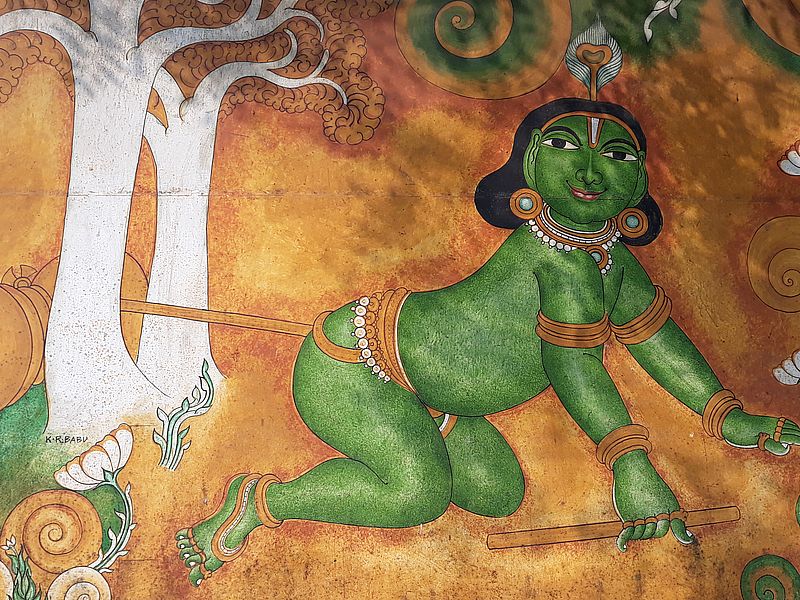
Индуисты настолько любят своих богов, что каждый год с большой радостью и любовью празднуют их Дни рождений. В лунном месяце Шравана (по индийскому календарю) или в августе-сентябре (по западному календарю) одним из главных фестивалей такого рода выступает Кришна Джанмаштами.
Как празднуется День явления Кришны
Как и многие праздники Индии, Кришна Джанмастами занимает 2 дня:
- Первый день проводится в приготовлениях: индуисты держат пост (или вовсе не едят ничего, или воздерживаются от зерно-бобовых), закупают все необходимые продукты и аксессуары для праздника, готовят большое количество праздничных блюд, молятся, поют бхаджаны, участвуют в киртанах, украшают домашние алтарики.
- Второй день начинается в 12 ночи, причем сразу – с празднования. Считается, что Господь Кришна пришел на Землю ровно в полночь. Поэтому его преданные дожидаются этого времени и начинают празднования в 00:00. Проводится торжественная пуджа и абхишека с предложением Ладду Гопалу (мурти маленького Кришны) пяти подношений: молока, меда, масла гхи, йогурта и сахара (пудры). Ритуал называется «панч амрита». После молитв, разрешается завершить пост. Все приготовленные заранее блюда предлагаются Бал Кришне, после чего их уже могут вкусить и члены семьи, гости. После того, как еда постояла на алтаре, перед изображением Божества, она превратилась в Кришна-прасад, который благотворно влияет на всех, кто его будет кушать.
Особенности празднования Кришна Джанмаштами
Индийцы очень любят детей, а божественного малыша-проказника Кришну – особенно. В день рождения Бога ему не только молятся, но и всячески украшают, отдают почести.
- Те, у кого дома имеется фигурка Ладду-Гопала и его подруги Радхарани Кишори Джи, покупают для них одежду (poshak), качель (jhula), всевозможные украшения. Обычно маленького Кришну одевают в красивую юбку, штанишки, корону с пером павлина, вешают на шею гирлянды цветов и бусы. В руки вкладывают миниатюрную флейту. Получается очень красиво!
- Кришна известен как большой любитель сладкого. К его Дню рождения в каждой индийской семье обязательно готовят сладости. Традиционные блюда этого дня: пирожки санджори с начинкой из сладкой манки, пончики балушахи или бадушах, расмалаи, ладду и т.п. В разных регионах страны список традиционных сладостей Шри Кришна Джанмаштами могут отличаться.
- Дети, подростки и молодежь с радостью переодеваются в этот день. Мальчики – в младенца Кришну (желтые одежды, корона, флейта, синее лицо), девочки – в Радху, спутницу Бога (красивое сари, украшения). На севере страны проводятся целые карнавалы с участием преданных.
- Особенно широко отмечается праздник в «кришнаитских местах«, которые исторически связаны с именем аватара Вишну или в которых живет большое количество преданных Гопала. Также праздник является главным в календаре для индуистов ISCON – последователей Шрилы Прабхупады. Южные регионы Индии празднуют День рождения Кришны более скромно, в семейном кругу.
- Цветы, украшения и даже огоньки как на Дивали – обычные спутники празднования Дня Кришны. Женщины скупают бархатцы и другие цветы, делают из них гирлянды для мурти и для украшения дома. Даже на улицах становится чисто и красиво. Повсюду цветы, поются мантры, ходят радостные люди.
- В этот день все индийцы приветствуют друг друга радостным: Счастливого Кришна Джанмаштами! (Happy Krishna Janmashtami), говорят Hare Krishna, Jay Sri Krishna и т.п.
Когда празднуется Кришна Джанмастами?
День явления Кришны отмечают ежегодно в месяц Шравана (август-сентябрь) на 8-ой день убывающей луны. Дата также должна выпадать на период накшатры Рохини.
В 2020 году Krishna Janmashtami отмечается 11-12 августа, в 2021 году День рождения Кришны будет праздноваться 29-30 августа, в 2022 году – 18-19 августа, в 2023 году – 6-7 сентября.
Когда религия на земле приходит в упадок и воцаряется безбожие, Я нисхожу Сам, о потомок Бхараты. Чтобы освободить праведников и покарать негодяев, Я Сам являюсь на Землю эпоха за эпохой. (Господь Кришна Арджуне, «Бхагавад-гита», гл. 4, текст 7-8.)
Когда настало время явления Господа Кришны, все созвездия заняли самое благоприятное положение. В этот момент повсюду — на востоке, на западе, на юге и на севере – установилась атмосфера мира и процветания. В небе видны были благоприятные сочетания звезд, а на земле – во всех городах и деревнях, на пастбищах и в мыслях людей – воцарилось счастье. («Источник вечного наслаждения», гл. 3.)
Шри Кришна Джанмаштами – день явления Господа Кришны. Господь Кришна явился на нашей планете, но не следует думать, что Он родился так же, как рождаемся мы. Существует 8400000 видов жизни, и пока мы существуем в материальном мире, мы перерождаемся из одного вида в другой вновь и вновь. Рождение Кришны иное. Поэтому Кришна говорит, что рождение Его следует воспринимать не как обычное, а как особое явление. Тот, кто понимает это, немедленно освобождается от материального мира. Как осознать эту истину? «Бхагавад–гита» объясняет это.
Тот, кто хочет познать Бога, Кришну, воистину, а не поверхностно, становится на путь преданного служения – бхакти. Бхакти, преданное служение Кришне, так чудесно! Празднование Джанмаштами – тоже бхакти. Джанмаштами празднуют все индусы, независимо от того вайшнавы они или нет. Праздник отмечается в каждом доме, точно так же, как в Западных странах празднуют Рождество.
Зачем Бог приходит на Землю? Для того, чтобы явить всему миру Свои исполненные сладости игры. Любое рождение – это тайна. Насколько же тайной является рождение Нерожденного? Появление Неявленного. Господь находится повсюду, но кто может распознать Его между атомами или фотонами света? Поэтому Господь говорит, что, стоит лишь человеку познать эту тайну, как освобождение не заставит себя долго ждать.
Наше общение с миром происходит посредством органов чувств. Глаза взаимодействуют с потоками света, в которых видны те или иные формы, уши впитывают звуки, ноздри общаются с ароматами. Проанализировав все формы взаимодействия органов чувств с объектами чувств, мы поймем, что все они в свою очередь – объект наблюдения нашего внутреннего «Я». Сумев затем с помощью Йоги узреть свой собственный ум, мы поймем, что наше «Я» не имеет ничего общего и с ним. Так мы приходим к пониманию себя, как наблюдателя. Мы наблюдаем этот мир через свои глаза, уши, язык и т.д., словно исследователь морских глубин, погрузившийся туда в батискафе. Задумавшись над природой наблюдателя и наблюдаемого, мы можем прийти к выводу, что наблюдатель – живой, тогда как наблюдаемое сознанием не обладает. И тем не менее, весь мир кажется нам живым. Это значит, что за этим миром стоит Высший Наблюдатель, Высшее Я, Высшая Душа. Так мы убеждаемся в существовании Бога.
Всё материальное мироздание – не что иное, как завеса, сквозь которую душа имеет возможность не видеть, не слышать, не дотрагиваться до Господа. Поэтому, чтобы явить Свою милость душам, обитающим здесь, Господь время от времени являет Себя. Его облик по природе относится к совершенно другой категории. В то время, как мы смотрим на мир сквозь материальные органы чувств, Господь охватывает взглядом все вселенные, включая и нашу планету, и делает Он это, разумеется, не с помощью ограниченных материальных инструментов, а с помощью Своих личных органов чувств, имеющих совершенно другую природу – природу духовную.
Все деяния Господа и вечно освобожденных душ, Его слуг, — духовны. Его рождение здесь – суть проявление Его вечной внутренней энергии, и все преданные Господа также пребывают под покровительством этой энергии, которая позволяет душе окунуться в изначальное состояние вечности, знания и блаженства. Рождение Кришны – событие уникальное. Это – праздник души, вечно свободной, любящей и счастливой. Несмотря на то, что на Земле он празднуется раз в год, этот день способен увлечь душу в Вечность, туда, где нет страданий, нет рождения и смерти, но есть вечная жизнь и великий подвиг любви, где исполняются все мечты, где кипит настоящая жизнь, где смеются и плачут от счастья, где душа находит себя.
Поделиться с друзьями
Добавить комментарий
Джанмаштами: День рождения Господа Кришны
Шри Кришна Джанмаштами, День явления Кришны — представляет собой знаменательный ведический праздник, который широко отмечается в Индии и других странах, где чтут ведические традиции или существуют индусские общины. Представляем вашему вниманию подборку фотографий, сделанных 2 сентября во время празднования Джанмаштами 2010 и историю этого религиозного праздника.
 Дети в День Рождения Кришны окрашивают лица в синий цвет и одеваются как Кришна.
Дети в День Рождения Кришны окрашивают лица в синий цвет и одеваются как Кришна.17) . Глава главного храма Удупи Кришна-матха соблюдает в этот день полный пост, а ночью, когда восходит луна, совершает омовение и проводит Шри Кришне особую пуджу, в ходе которой Господу предлагаются разнообразные сладости.
18) На следующий день, после особой утренней пуджи, собравшимся гостям раздают угощение. А в полдень проводят шествие – глиняное мурти Господа Кришны помещают на золотую колесницу в золотых украшениях и везут по роскошно украшенной по такому случаю центральной площади Удупи.
Смотрите также: Лучшие посты на БигПикче Топ-100
А вы знали, что у нас есть Telegram и Instagram?
Подписывайтесь, если вы ценитель красивых фото и интересных историй!
Шри Кришна-джанмаштами маха-махотсава. День Рождения Шри Кришны
Автор: Шри Шримад Бхактиведанта Свами Прабхупада
/Лекция на Кришна Джанмаштами, 16 августа 1968 года, Монреаль/
Сегодня праздник явления или рождения Господа Кришны. В Бхагават-Гите Господь говорит:
джанма карма ча ме дивйам
эвам̇ йо ветти таттватах̣
тйактва̄ дехам̇ пунар джанма
наити ма̄м эти со ’рджуна
(«Бхагавад-гита» глава 4, стих 9)
Мой дорогой Арджуна. Любой, кто просто пытается понять мои трансцендентные рождения или явления и уход и деятельность, джанма карма. Личность Бога не является нишкрия. Бездействующей.
Поэтому каждый, кто может понять какой деятельностью занят Господь, и какое рождение он принимает. Просто понимая две эти вещи, человек получает замечательный результат.
В чём он? Оставляя это тело, он не принимает рождение в этом материальном мире. Некоторые из нас могут думать, что это означает просто уничтожение, — нет. Он не приходит в этот материальный мир, но он приходит ко Мне. Мам эти означает что Верховная Личность Бога, у него есть обитель, куда мы можем отправиться, просто постигая природу его появлений и деятельности.
Итак, сегодня очень благоприятный день, Джанмаштами. Когда Господь Кришна явился 5000 лет назад в Индии, в Матхуре. Те двое индусов, мужчина и женщина, которые присутствуют, они очень хорошо знают, где находится Матхура. Это примерно в 90 милях к югу от Нью-Дели. Матхура существует до сих пор. И она существует вечно.
Кришна появился в Матхуре в доме дяди по материнской линии, в очень ненадёжных условиях. Место его рождения, место рождения Господа Кришны теперь содержится очень аккуратно. Тот, кто едет в Индию, может увидеть. Так или иначе, Господь Кришна появился на этой планете, 5000 лет назад. Теперь Кришна говорит джанма карма ча ме дивйам.
Дивйам означает необыкновенный. Не следует понимать Его рождение как наше. Кришна не принимает рождения, как мы. Это также объясняется в Бхагават-Гите. Когда Арджуна спросил у Кришны: Мой дорогой Кришна, ты говоришь, что прежде ты рассказал эту систему йоги Бхагават-Гиты Богу Солнца. Это означает, что ты рассказывал об этом миллионы и миллионы тлеет назад. Как можно поверить в это? Поскольку Кришна был современником Арджуны, поэтому он считал, что Кришна мой друг. Он мой двоюродный брат. Как возможно, что Он рассказал эту Бхагават-Гиту богу Солнца? И каков же был ответ?
Ответ был таким: Ты также появляешься много-много раз, я также появляюсь много-много раз. Различие в том, что Я могу помнить. А ты не можешь. Такова разница между Богом и обычным живым существом. Который также принимает одно рождение за другим. Существует 8 млн 400 тыс форм жизни. И до тех пор, пока мы в этом материальном мире, мы крутимся в этом круге рождения и смертей. Но Кришна не рождается таким образом. Поэтому Кришна говорит джанма карма ча ме дивйам эвам йо ветти таттватах. Таттватах означает в истине. Не поверхностно, научно. Тот, кто знает, может немедленно получить освобождение.
И как можно понять такие истины? Это также объясняется в Бхагават-Гите.
Опять тоже самое, таттватах, в истине. Если кто-то хочет узнать Бога, или Кришну в истине, не поверхностно, тогда он должен принять процесс преданного служения. Бхактйя. В другом месте Кришна говорит
патрам̇ пушпам̇ пхалам̇ тойам̇
йо ме бхактйа̄ прайаччхати
тад ахам̇ бхактй-упахр̣там
аш́на̄ми прайата̄тманах̣
(«Бхагавад-гита» глава 9, стих 26)
Если человек предлагает мне небольшой фрукт, немного воды, небольшой цветок, но с преданностью, бхактйя, это единственная квалификация. Поэтому Кришна говорит поскольку он даёт это с преданностью, с верой и любовью, — Я ем. Кришна ест. В храме мы предлагаем прасад, он ест, потому что он говорит, Я ем.
Как вы можете говорить, что Он не ест? Один джентльмен спросил у меня, свамиджи, вы предлагаете прасадам в храме, но считаете ли вы, что Кришна или Бог, ест? Я ответил: Да, почему же нет? Он сказал: Я ем. Как вы можете говорить, что он ест. Но вы не знаете, как ест он.
Благодаря незначительным знаниям вы считаете, что Бог не ест. Но процесс этот, он отличен на это отвечает Брахма самхита. В ней говорится: чувства Господа, чувства Кришны могущественны все в равной степени. Также, как я могу видеть своими глазами, Кришна может есть своими глазами. И существует очень много примеров.
Кришна или Вишну. Первое это здание. Гарбходакашайи Вишну. Ложится на океан, и Брахма создаётся из его пупа. Есть стебель лотоса, вырастающего из живота Господа, на котором рождается Брама. Лакшми, богиня удачи, просто восседает, но если понимаем, если мы зачинаем ребёнка, необходимо сотрудничество с женой, здесь мы видим что жена просто сидит, но он зачинает Браму из своего пупа. Это называется сарва шактиман. Ему не требуется ничья поддержка или помощь. Он может зачать ребёнка. Совсем не так, как мы зачинаем ребёнка. Он находится в сердце, он повсюду, он может появиться отовсюду. Как Солнце восходит на востоке, это не значит, что восток является матерью Солнца. Мы просто видим, что Солнце восходит на Востоке.
Таким образом, если мы попытаемся понять истину, тогда мы можем понять, что есть Бог. Внешне, если мы пытаемся понять нашим экспериментальным знанием, нет возможности понять Бога.
преманджана-ччхурита-бхакти-вилочанена
сантах садаива хридайешу вилокайанти
йам шйамасундарам ачинтйа-гуна-сварупам
говиндам ади-пурушам там ахам бхаджами
(«Брахма-самхита» 5.38)
Брахма-самхита говорит если кто то пускается на колеснице по воздуху со скоростью ума, тем не менее, он не сможет понять, что есть Бог.
Его нельзя понять, просто изучая Веды. Необходимо превзойти также положение Вед. Тогда человек сможет понять, что есть Бог, или что есть Кришна. Этот процесс объясняется в Бхагават-Гите так.
То есть бхакти, преданное служение Кришне, это настолько хорошо, конечно, этот праздник Джанмаштами, празднуется всеми индусами. Вне зависимости от того, является они вайшнавами или нет. Этот праздник отмечается в Индии в каждом доме. Как в ваших западных странах рождество празднуется в каждом доме, аналогично Джанмаштами празднуется в каждом доме.
Сегодня очень большой праздничный день. И в нашей программе в 12 часов ночи, когда Господь рождается, мы будем приветствовать Его. А теперь, пока 10 часов, и в течении 2-х часов наша программа будет продолжаться в киртане.
Киртан означает иногда пение под музыку, а иногда разговор. И то и другое киртан. Когда бы мы ни прославляли Господа, это называется киртан. Чтение Шримад Бхагаватам это также киртан. Ваясики, Шукадева Госвами, он достиг высшего совершенства, освобождения просто декламируя Шримад Бхагаватам. Парикшит махарадж, он просто слушал.
Существует 9 процессов преданного служения. Шраванам киртанам Вишну смаранам пада севанам, воспевание слушание, сначала слушание, затем воспевание, без слушания никто не может повторять, и какое это шраванам киртанам? Вишну. Вишну, и ни кого либо ещё.
ш́раван̣ам̇ кӣртанам̇ вишн̣ох̣
смаран̣ам̇ па̄да-севанам
арчанам̇ ванданам̇ да̄сйам̇
сакхйам а̄тма-ниведанам
(«Шримад-Бхагаватам» песнь 7, глава 5, стих 23)
Это 9 процессов преданного служения из которых шраванам, слушание, является самым важным. Без слушания никто не может понять науку о Боге. Поэтому ведические мантры называется шрути.
Шрути означает то, что должно быть услышано. Это не то, что должно быть проверено в лаборатории. Это просто должно быть услышано. Поэтому находится шрути. Шраванам киртанам вишнох смаранам пада-севанам арчанам ванданам дасйам. Ванданам – предложение молитв. Мы также предлагаем молитвы.
В других религиях, таких, как христианство, тоже предлагают молитвы, мусульмане также предлагают молитвы. И предложение молитв также является составляющей бхакти. Повторение, слушание, размышление, предложение молитв, арчанам, поклонение божеству в храме, все они вместе составляют преданное служение. И из всех этих процессов вы можете выполнять все 9, — это очень хорошо, но это невозможно. И даже, если вы выполняете одно – вы становитесь совершенным. Это очень хорошо. Как махараджа Парикшит, он просто слушал, занимался процессом слушания, и достиг совершенства.
Аналогично, Ваясаки означает Шукадева Госвами просто прославлял Господа. Прахлада Махарадж просто медитировал. Существует много примеров. Просто следуя одному из принципов преданного служения, они достигали высшего совершенства жизни, освобождения, и возвращались домой, назад к Богу.
Поэтому мы приглашаем сегодня говорить о Кришне, наших учеников, и всех наших членов здесь, в настоящее время.
Шри Кришна Джанмаштами — день явления Господа Шри Кришны
Когда религия на земле приходит в упадок и воцаряется безбожие, Я нисхожу Сам, о потомок Бхараты. Чтобы освободить праведников и покарать негодяев, Я Сам являюсь на Землю эпоха за эпохой». (Господь Кришна Арджуне, «Бхагавад-гита» 4.7-8)
Когда настало время явления Господа Кришны, все созвездия заняли самое благоприятное положение. В этот момент повсюду — на востоке, на западе, на юге и на севере – установилась атмосфера мира и процветания. В небе видны были благоприятные сочетания звезд, а на земле – во всех городах и деревнях, на пастбищах и в мыслях людей – воцарилось счастье. («Источник вечного наслаждения», гл. 3.)
ДЕНЬ, КОГДА РОДИЛСЯ БОГ
Джанмаштами, или День явления Господа Кришны — один из самых главных и важных праздников для последователей индуизма и особенно гаудиа-вайшнавизма во всем мире. В этот день в наш мир, на Землю, пришел Бог в своем изначальном духовном облике Кришны. И этот праздник удивителен по своему значению и благу, который он приносит людям.
Зачем всемогущий, самодостаточный Господь пришел в материальный мир? На этот вопрос Он Сам отвечает в Бхагавад-гите: «Когда религия на земле приходит в упадок и воцаряется безбожие, Я нисхожу Сам, о потомок Бхараты. Чтобы освободить праведников и покарать негодяев, Я Сам являюсь на Землю эпоха за эпохой». И Он освобождает не только праведников, которым посчастливилось родиться в то время, пока Он был на Земле, но и дает такой шанс всем обусловленным душам на все последующие века. Как? Оставляя Священные писания с духовным знанием и описанием удивительных игр Бога, что позволяет нам помнить о Господе и взращивать желание вернуться в Нему в духовный мир.
День явления Кришны — самое благоприятное время вспомнить о Его играх, погрузиться в мысли о Нем, попросить Его помочь нам на нашем пути домой, в духовный мир. Поэтому в Джанмаштами очень важно и благоприятно читать книги и слушать лекции Шрилы Прабхупады и духовных учителей о Кришне и Его явлении, обсуждать эти повествования с преданными. В «Источнике вечного наслаждения» удивительно красиво описывается рождение Кришны. «Когда настало время явления Господа Кришны, все созвездия заняли самое благоприятное положение. В этот момент повсюду — на востоке, на западе, на юге и на севере – установилась атмосфера мира и процветания. В небе видны были благоприятные сочетания звезд, а на земле – во всех городах и деревнях, на пастбищах и в мыслях людей – воцарилось счастье». Из Шримад-Бхагаватам можно узнать об исполненных блаженства играх Кришны — Его рождении в семье Нанды Махараджа и Матушки Яшоды, о Его детских развлечениях, убийстве демонов, олицетворяющих человеческие пороки — жадность, гордость, вожделение. Слушание этих рассказов помогает избавиться от пороков и обрести духовное сознание. Господь -всеблагой, и даже убитые им демоны получают высочайшее благо, что уж говорить о тех, кто старается служить Кришне и помнить о Нем как о Верховной личности Бога!
В Джанмаштами во многих храмах Индии и во всех центрах сознания Кришны в мире, которые благодаря Шриле Прабхупаде сегодня есть практически во всех городах, проходят праздничные программы. Очень важно и благоприятно приходить на них, чтобы погрузиться в слушание повествований о Кришне, обсуждение Его игр, в молитвы и служение преданным. И тогда Кришна, несомненно, ответит на наши молитвы и поможет нам очиститься от материальной обусловленности, обрести духовное сознание и, в конечном счете, вернуться к Богу, в исполненный блаженства вечный духовный мир.
БОЖЕСТВЕННОЕ ЯВЛЕНИЕ
Свыше пяти тысяч лет назад, в день, когда все самые важные планеты заняли наиболее благоприятное положение и повсюду — на востоке, на западе, на юге и на севере — установилась атмосфера мира и процветания, в Матхуре (город приблизительно в нескольких часах езды от нынешней столицы Индии Нью-Дели) родился младенец. «В небе были видны удачные сочетания звезд, а на земле — во всех городах и деревнях, на пастбищах и в мыслях людей — воцарилось счастье», — рассказывается в «Шримад-Бхагаватам», одной из самых древних священных книг мира.
Предание гласит, что 5 тысяч лет назад жестокий царь Камса заточил в тюрьму свою сестру Деваки и ее мужа по имени Васудева. В свое время голос с неба предупредил Камсу, что восьмой ребенок Деваки станет причиной его смерти. Вот почему Камса бросил Деваки и Васудеву в темницу. Царь внял небесному голосу и решил убивать всех младенцев Деваки сразу при рождении. Однако отец мальчика сумел вынести маленького Кришну, восьмого ребенка, из дворца. Все обитатели дворца погрузились в сон, а река Ямуна на миг остановила свой бурный поток, чтобы пропустить Васудеву с божественным ребенком на другой берег. Васудева принес сына в Гокулу, в дом своего дорогого друга Нанды Махараджи, жена которого, Яшода-деви, только что родила прелестную девочку. Оставив своего сына и забрав девочку, Васудева вернулся в тюрьму, и никто не заметил его отсутствия. Камса узнал, что младенец, которого он так боялся, уже родился и играет где-то неподалеку, и постоянно посылал своих друзей-демонов убить Кришну, но безуспешно. Все эти демоны олицетворяют различные пороки: лицемерие, злобу, зависть, гордыню, — и любой, кто читает или слушает о событиях той далекой эпохи, очищает свое сердце от этих извечных врагов души.
КАК ВЫГЛЯДИТ ГОСПОДЬ, ПРЕБЫВАЮЩИЙ В СЕРДЦЕ ЖИВЫХ СУЩЕСТВ?
«Знай же, что всё чудесное, прекрасное и величественное в этом мире — лишь крошечная искра Моего великолепия» / Бхагавад-гита, 10.41
В «Шримад-Бхагаватам» (2.2.8-12) Шукадева Госвами описывает форму Господа: «Другие сосредоточивают свой ум на находящейся в области сердца Личности Бога величиной не более пяди. В четырех руках Он держит лотос, колесо от колесницы, раковину и палицу. Его уста выражают радость, продолговатые глаза по форме напоминают лепестки лотоса, желтоватые, как шафран цветка кадамбы, одежды украшены драгоценными камнями. Все Его украшения сделаны из золота и усыпаны самоцветами. На Нем сверкающий головной убор, а в ушах – серьги. Его лотосные стопы покоятся в центре лотосоподобных сердец великих мистиков. На груди у Него драгоценный камень каустубха с изображением прекрасного теленка, а на плечах – других драгоценные камни. Весь Его торс украшен гирляндами из свежих цветов. На Его талии искусно расшитый пояс, а на пальцах перстни с драгоценными камнями. Его запястья, браслеты на ногах, умащенные ароматическими маслами волосы с синеватым отливом и прекрасное улыбающееся лицо радуют глаз. Великодушие Господа, проявленное в Его играх, взгляд Его лучистых глаз и озаренное улыбкой лицо свидетельствуют о Его безграничной милости. Поэтому все время, пока человек способен удерживать свой ум в медитации на Господа, он должен сосредоточивать внимание на этом трансцендентном образе Господа».
ПОЧЕМУ КРИШНА НИСХОДИТ В ЭТОТ МИР
Ведические писания утверждают, что Шри Кришна — Верховная Личность Бога, первопричина всех причин. В переводе с санскрита Кришна означает «Всепривлекающий». Кришна, хотя и является источником материального творения, Он никогда не соприкасается с материей и является в своем изначальном духовном теле, состоящем из вечности, знания и блаженства.
Кришна нисходит в материальный мир в самые сложные времена, когда в жизни людей воцаряется хаос, неправедность, леность, жестокость и безбожие. Согласно упоминаниям великого ведического мудреца и величайшего из историков древности Вьясадевы, такие времена и настали 5000 лет назад. В то время в семьях правителей преобладала неправедность и бесчестие. Именно поэтому Господь Шри Кришна и явился, чтобы напомнить человечеству об истинных ценностях и дать знание о праведном гармоничном образе жизни.
Это тайное знание было поведано Кришной Его лучшему другу – Арджуне. И каждому из нас очень повезло, поскольку эта беседа была записана Шрила Вьясадевой и названа «Бхагавад-гитой».
В переводе с санскрита «Бхагавад-гита» означает «Божественная песнь». Изучив «Бхагавад-гиту» мы сможем обрести самое важное знание в жизни: ведь с друзьями делятся только лишь самым лучшим и важным. А в этой книге сам Господь открывает тайны вечности и блаженства Своему лучшему другу, который оказался в плену относительных аспектов жизни.
КАК ОТМЕЧАЮТ ДЖАНМАШТАМИ
В этот благоприятный день ликует весь мир. Все полубоги на райских планетах поют гимны Верховной Божественной Личности Шри Кришне. Вся Земля ликует, вспоминая время, когда Шри Кришна касался ее своими подобными лотосам стопами. Все преданные Кришны — вайшнавы, исполнены ликования и беспрестанно поют сладкие киртаны и баджаны Божествам Кришны в храмах по всему миру.
По сути и по форме, день рождения (явления) того, кто есть «нить, на которой держатся жемчужины ожерелья» — для индийцев такой же праздник как для европейцев Рождество. Джанмаштами в Индии встречают все, независимо от вероисповедания: и кришнаиты, и шиваиты, и даже христиане с мусульманами. Людской поток устремляется в храмы, чтобы предложить божеству Кришны разные подношения: сладости, фрукты, цветы, светильники, благовония, песни, танцы. Божество Кришны на алтаре брахманы омывают ключевой водой, йогуртом, молоком, фруктовыми соками и медом. С раннего утра и до поздней ночи люди славят Бога, воспевая Его имена, говорят и просто помнят о Нем. Яркая иллюминация, толпы паломников в нарядных одеяниях, вездесущие торговцы — Джанмаштами на редкость зрелищное действо.
Но если на минуту отвлечься, уйти с шумной, праздничной улицы и заглянуть в окна домов, то вы обнаружите, что Джанмаштами — вполне себе домашний и семейный праздник, поскольку божество Кришны есть в каждом доме. И, без преувеличения, это полноправный член семьи, требующий любви и заботы и отвечающий людям тем же. Такое ощущение близости с Богом считается высшим совершенством жизни.
В Джанмаштами держат пост до полуночи, а затем, в назначенный час, раздают угощение из 108 блюд.
Согласно официальной версии, в России праздновать явление Кришны начали в 1980-х годах, а в столице — с 1988 года. Однако, есть и другие мнения. Так в частности, по некоторым сведениям, Джанмаштами праздновали еще при первых купцах-индусах в Астрахани чуть ли не 400 лет назад. Так что, похоже, у Джанмаштами в России довольно богатая история.

